第二节: 并发编程之synchronized/Lock和AQS详解
第一部分: synchronized
临界资源
在多线程并发过程中,有可能会出现多个线程同时出现访问同一个共享,可变资源的情况。这个资源可能是变量、文件、对象等。
共享:资源可以由多个线程同时访问
可变:资源可以在其生命周期内修改
引发的问题:
由于线程的过程是不可控的,所以需要采用同步机制来对协同对象可变状态的访问。
Java 中,提供了两种方式来实现同步互斥访问:synchronized 和 Lock
同步器的本质就是加锁
加锁目的
序列化访问临界资源:即在任一时刻,只能有一个线程访问临界资源,也称为 同步互斥访问。
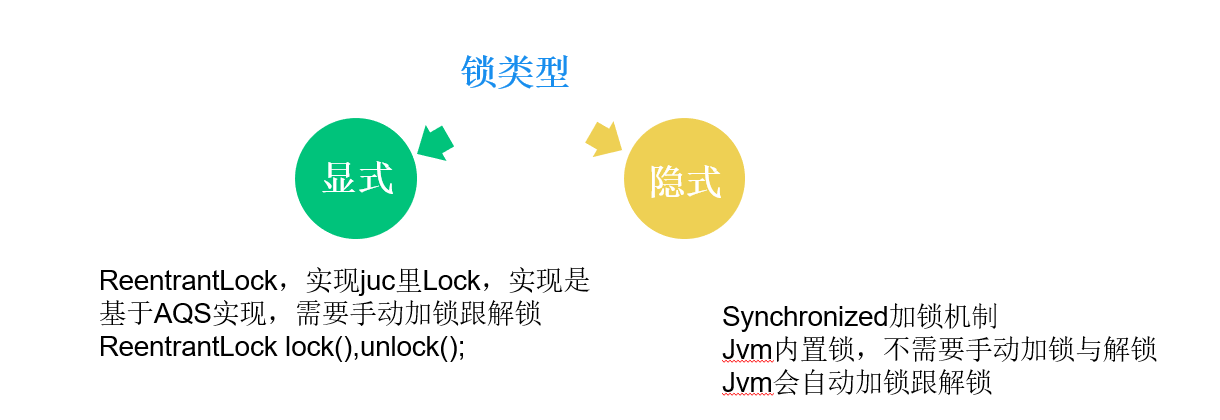
JAVA锁体系
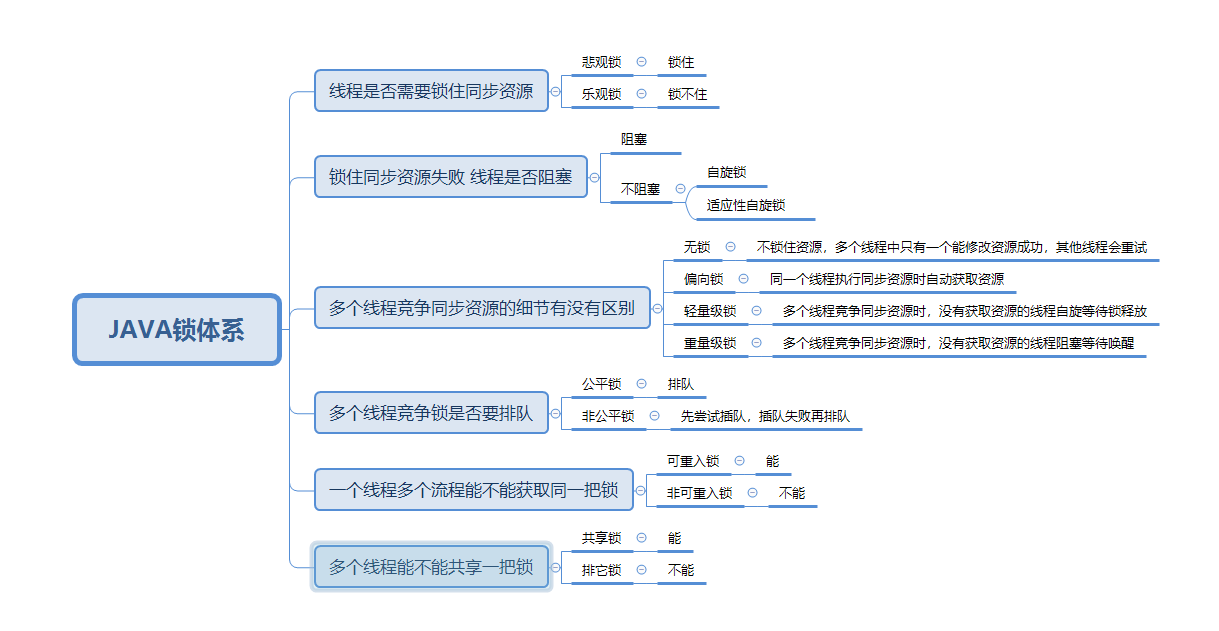
JAVA线程生命状态

synchronized原理详解
synchronized内置锁是一种对象锁,(锁的是对象而非引用),作用粒度是对象,可以用来实现对临界资源的同步互斥访问,是可重入的。
加锁的方式:
1. 同步实例方法 锁是当前实例对象

2. 同步类方法 锁是当前类对象
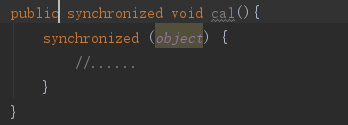
3. 同步代码块 锁是括号里面的对象

synchronized不能跨方法保证原子性,那如何实现跨方法保证? --- Unsafe类monitorenter和monitorexit来实现。
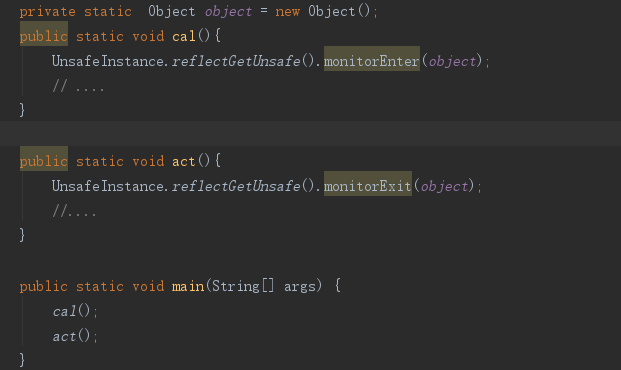
synchronized底层原理
synchronized是基于底层JVM内置锁实现,通过内部对象Monitor(监控器锁)实现,基于进入和退出Monitor对象实现方法和代码块同步,监视器锁的实现依赖底层操作系统的Mutex Lock(互斥锁)实现,它是一个重量级锁性能较低。
synchronized关键字被编译成字节码后会被翻译成monitorenter 和 monitorexit 两条指令分别在同步块逻辑代码的起始位置与结束位置。
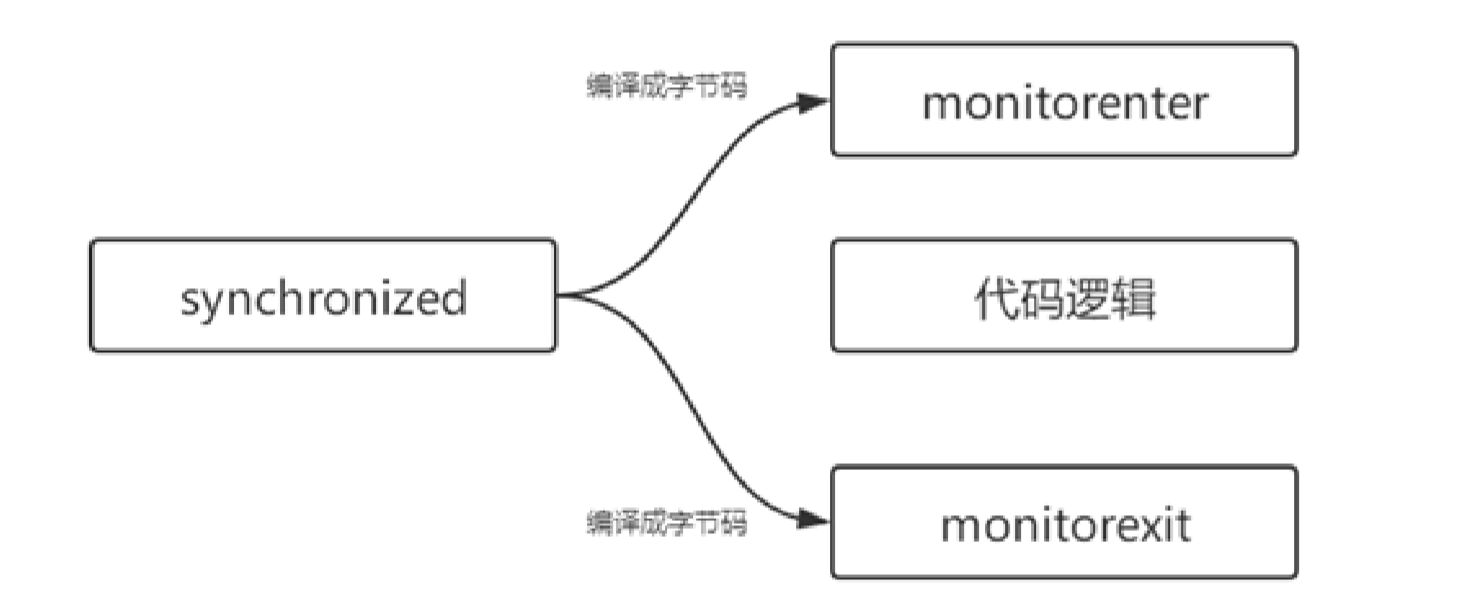
每个同步对象都有一个自己的Monitor(监视器锁),加锁过程如下图所示:
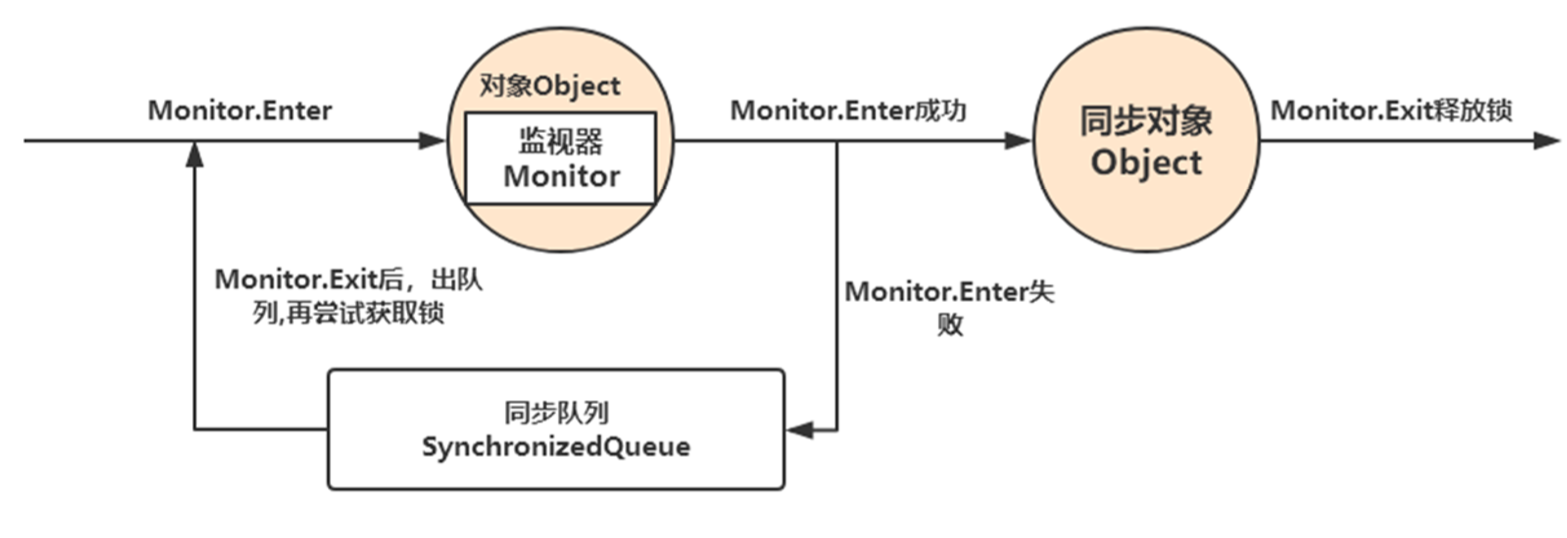
问题:synchronized加锁加在对象上,对象是如何记录锁状态的呢?
-- 锁状态是被记录在每个对象的对象头(Mark Word)中.
对象的内存布局
HotSpot虚拟机中,对象在内存中存储的布局可以分为三块区域:对象头(Header)、实例数据(Instance Data)和对齐填充(Padding).
-- 对象头:比如 hash码,对象所属的年代,对象锁,锁状态标志,偏向锁(线程)ID,偏向时间,数组长度(数组对象)等
-- 实例数据:即创建对象时,对象中成员变量,方法等
-- 对齐填充:对象的大小必须是8字节的整数倍
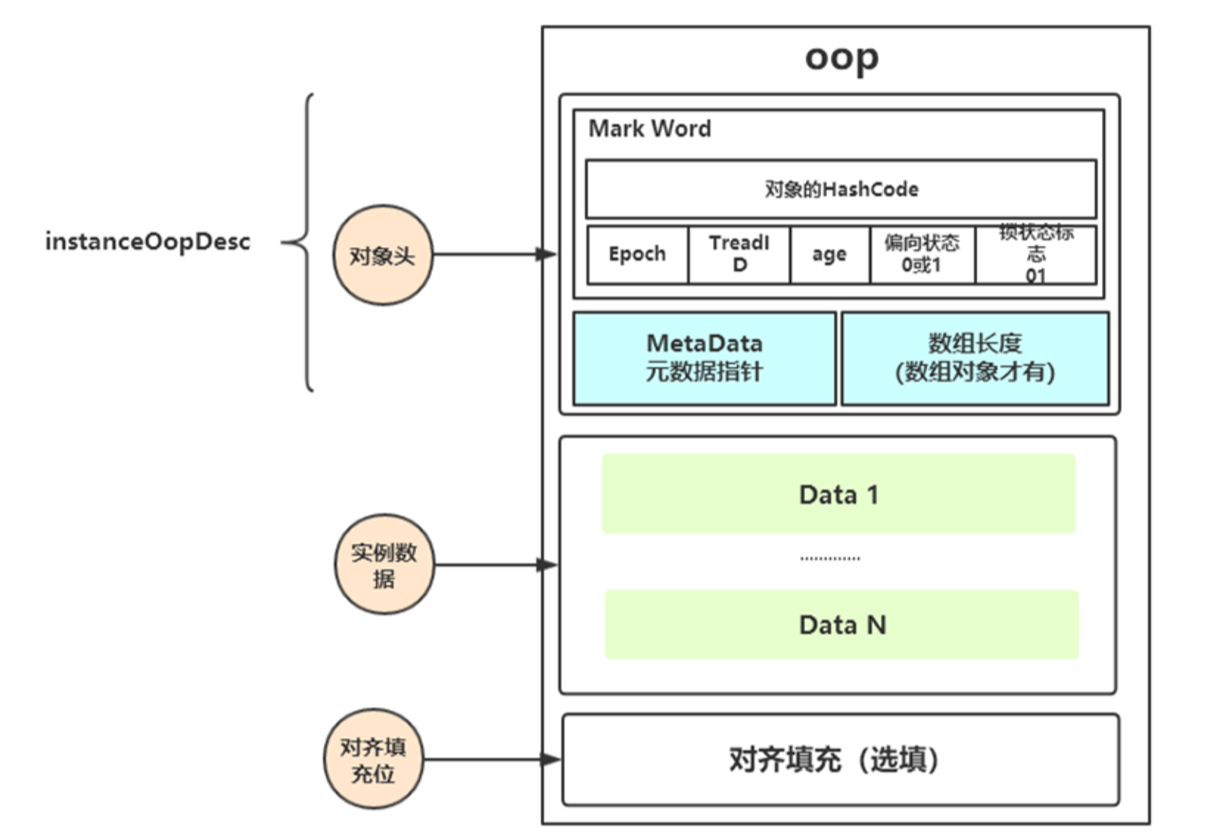
JVM内置锁在1.5之后版本做了重大的优化
如锁粗化(Lock Coarsening)、锁消除(Lock Elimination)、轻量级锁(Lightweight Locking)、偏向锁(Biased Locking)、适应性自旋(Adaptive Spinning)等技术来减少锁操作的开销,,内置锁的并发性能已经基本与Lock持平.
锁粗化举例:
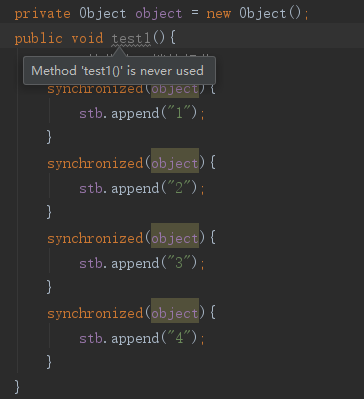 ===锁粗化===》
===锁粗化===》 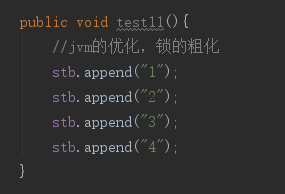
锁消除举例:
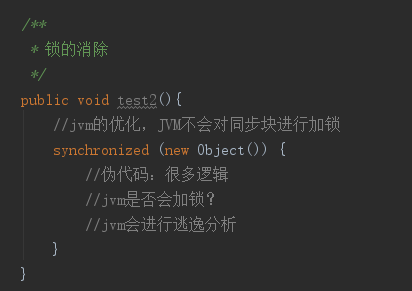
逃逸分析
使用逃逸分析,编译器可以对代码做如下优化:
一、同步省略。如果一个对象被发现只能从一个线程被访问到,那么对于这个对象的操作可以不考虑同步。
二、将堆分配转化为栈分配。如果一个对象在子程序中被分配,要使指向该对象的指针永远 不会逃逸,对象可能是栈分配的候选,而不是堆分配。
三、分离对象或标量替换。有的对象可能不需要作为一个连续的内存结构存在也可以被访问 到,那么对象的部分(或全部)可以不存储在内存,而是存储在CPU寄存器中
在Java代码运行时,通过JVM参数可指定是否开启逃逸分析,
-XX:+DoEscapeAnalysis : 表示开启逃逸分析
-XX:DoEscapeAnalysis : 表示关闭逃逸分析
从jdk 1.7开始已经默认开始逃逸分析,如需关闭,需要指定-XX:DoEscapeAnalysis
public class StackAllocTest { /** * 进行两种测试 * 关闭逃逸分析,同时调大堆空间,避免堆内GC的发生,如果有GC信息将会被打印出来 * VM运行参数:-Xmx4G -Xms4G -XX:-DoEscapeAnalysis -XX:+PrintGCDetails -XX:+HeapDumpOnOutOfMemoryError * * 开启逃逸分析 * VM运行参数:-Xmx4G -Xms4G -XX:+DoEscapeAnalysis -XX:+PrintGCDetails -XX:+HeapDumpOnOutOfMemoryError * * 执行main方法后 * jps 查看进程 * jmap -histo 进程ID */ public static void main(String[] args) { long start = System.currentTimeMillis(); for (int i = 0; i < 500000; i++) { alloc(); } long end = System.currentTimeMillis(); //查看执行时间 System.out.println("cost-time " + (end - start) + " ms"); try { Thread.sleep(100000); } catch (InterruptedException e1) { e1.printStackTrace(); } } private static TulingStudent alloc() { //Jit对编译时会对代码进行 逃逸分析 //并不是所有对象存放在堆区,有的一部分存在线程栈空间 TulingStudent student = new TulingStudent(); return student; } static class TulingStudent { private String name; private int age; } }
关闭逃逸分析:
关闭逃逸分析,同时调大堆空间,避免堆内GC的发生,如果有GC信息将会被打印出来
VM运行参数:-Xmx4G -Xms4G -XX:-DoEscapeAnalysis -XX:+PrintGCDetails -XX:+HeapDumpOnOutOfMemoryError

执行结果:
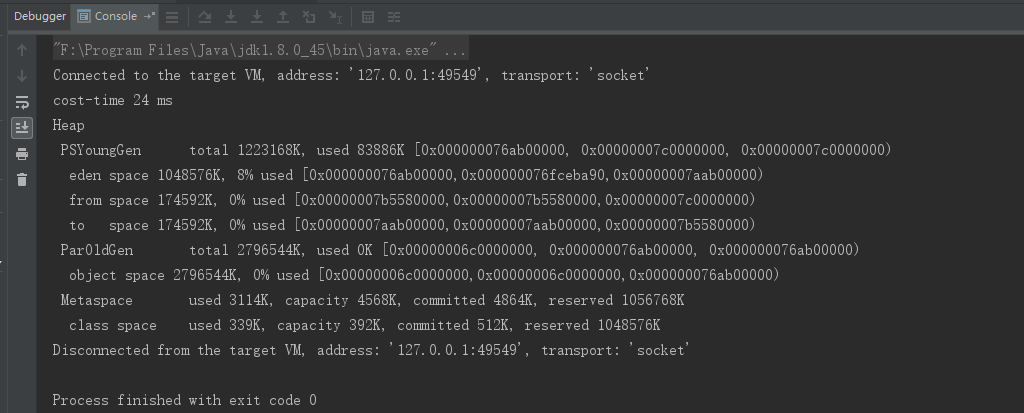
查看线程 jps
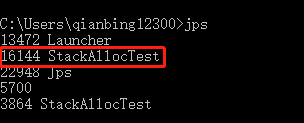
分析进程 jmap -histo + 进程号
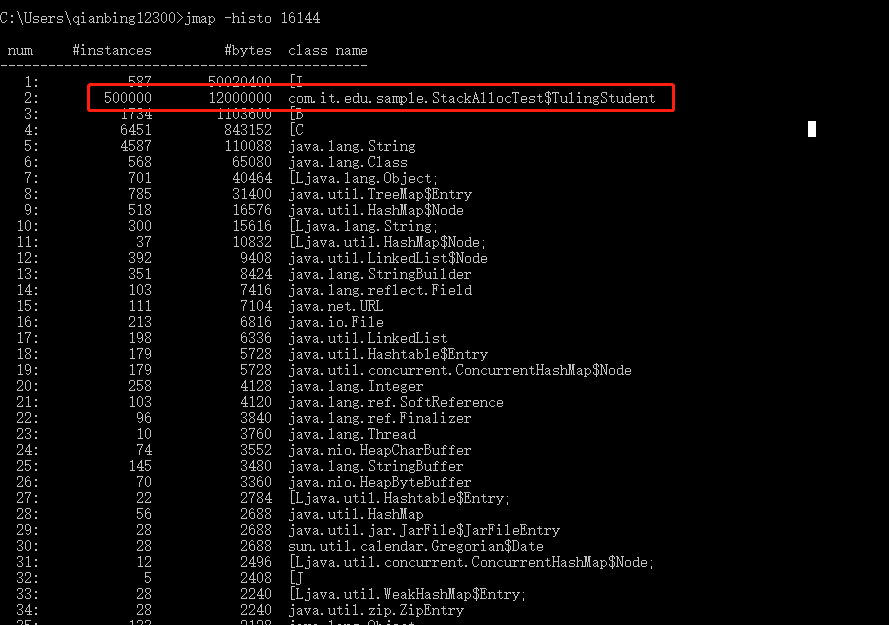
打开逃逸分析:
开启逃逸分析,同时调大堆空间,避免堆内GC的发生,如果有GC信息将会被打印出来
VM运行参数:-Xmx4G -Xms4G -XX:+DoEscapeAnalysis -XX:+PrintGCDetails -XX:+HeapDumpOnOutOfMemoryError



问题: 是不是实例对象都存放在堆区?
-- 不一定,如果实例对象没有线程逃逸行为,实例对象存放在堆区;如果有线程逃逸行为,则有可能部分存在线程栈中。
如果实例对象存储在堆区,实例对象内存存在堆区,实例的引用存在栈上,实例的元数据class存放在方法区或元空间。




轻量级锁使用场景:
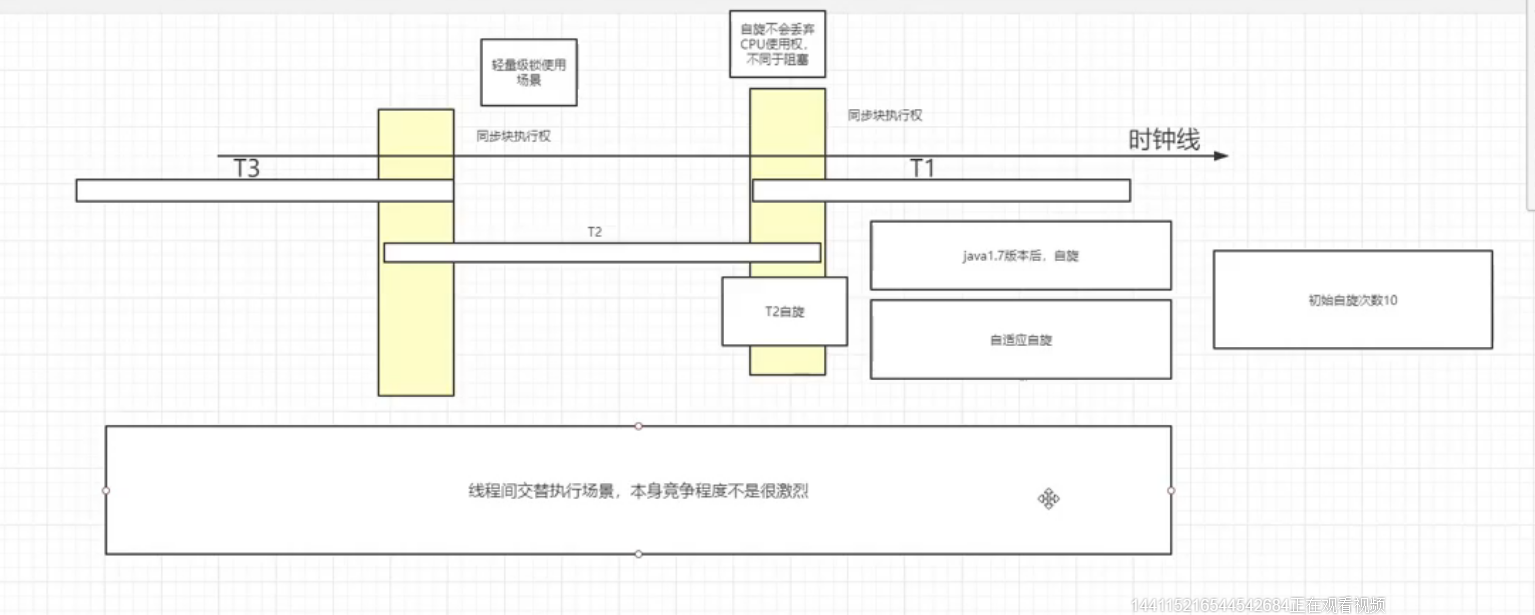
锁的升级过程拆分
JVM锁的膨胀升级过程场景一:
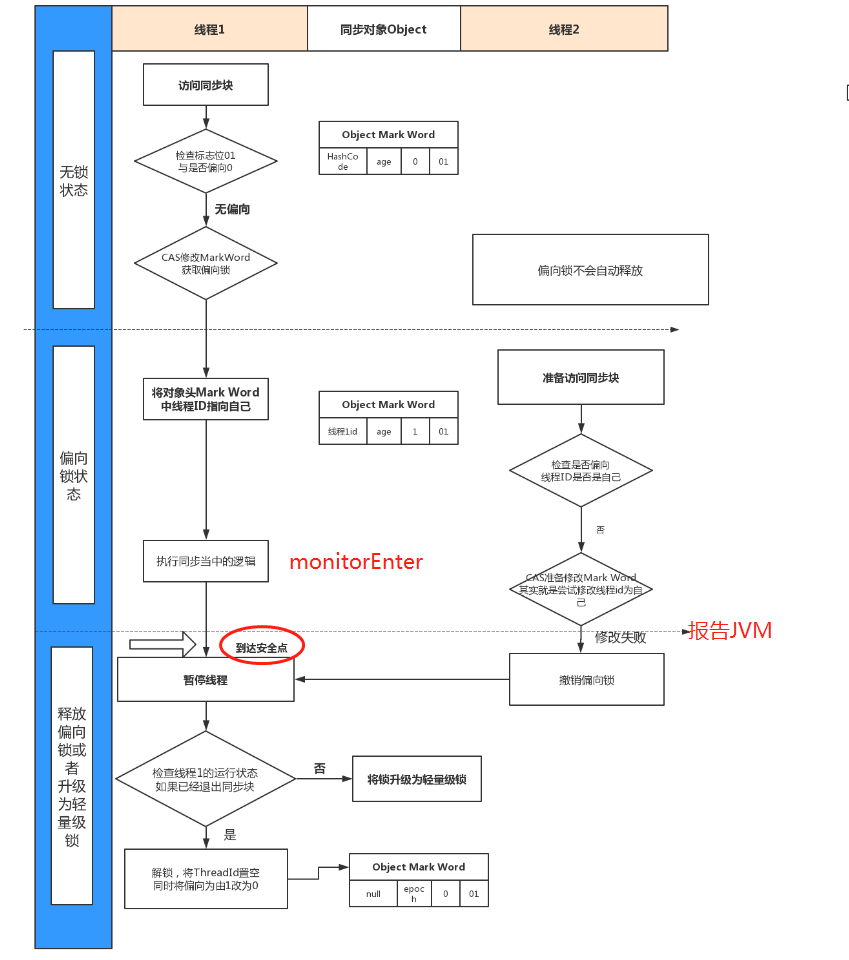
JVM锁的膨胀升级过程场景二:
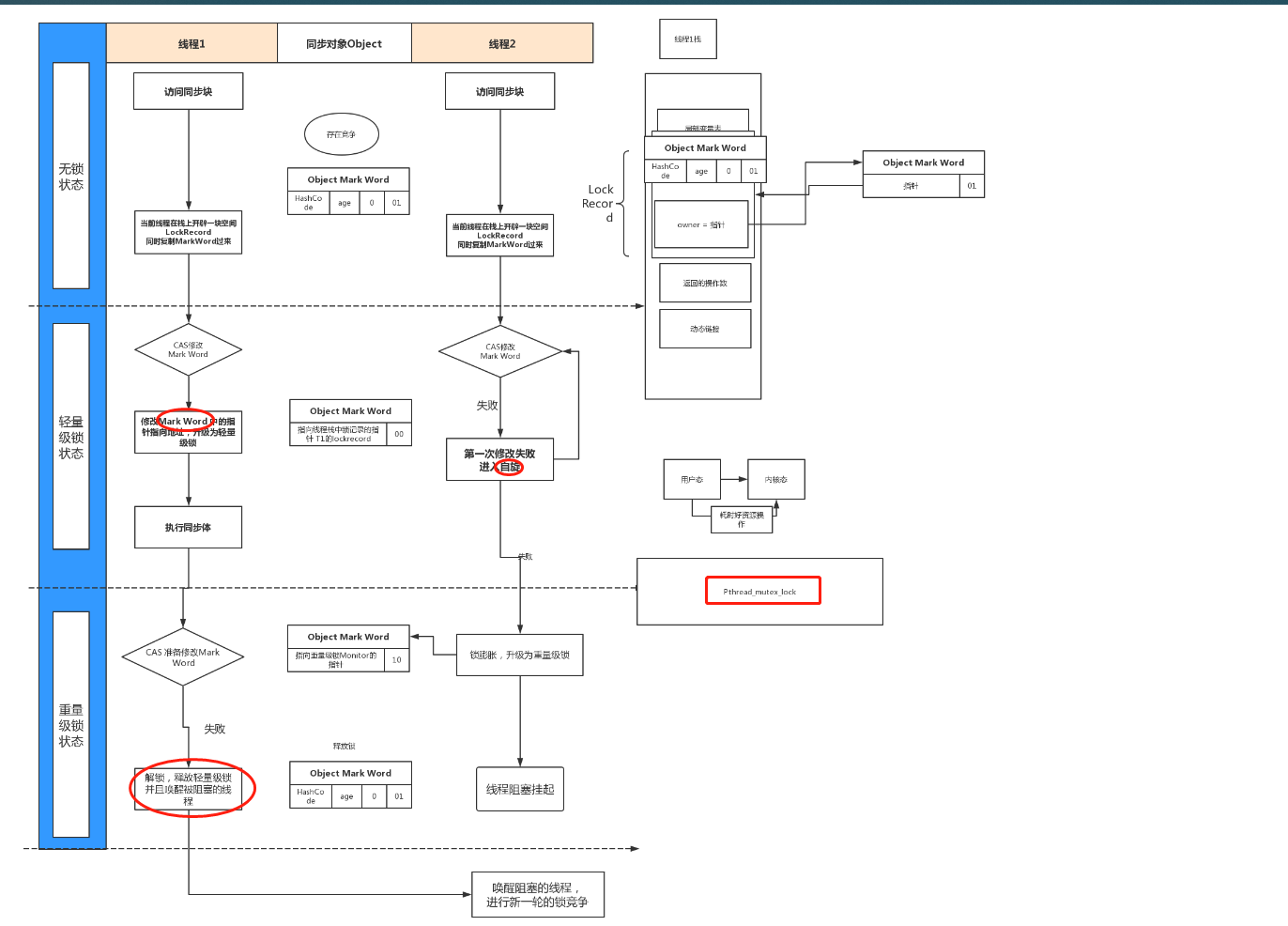
锁的升级过程明细如下:
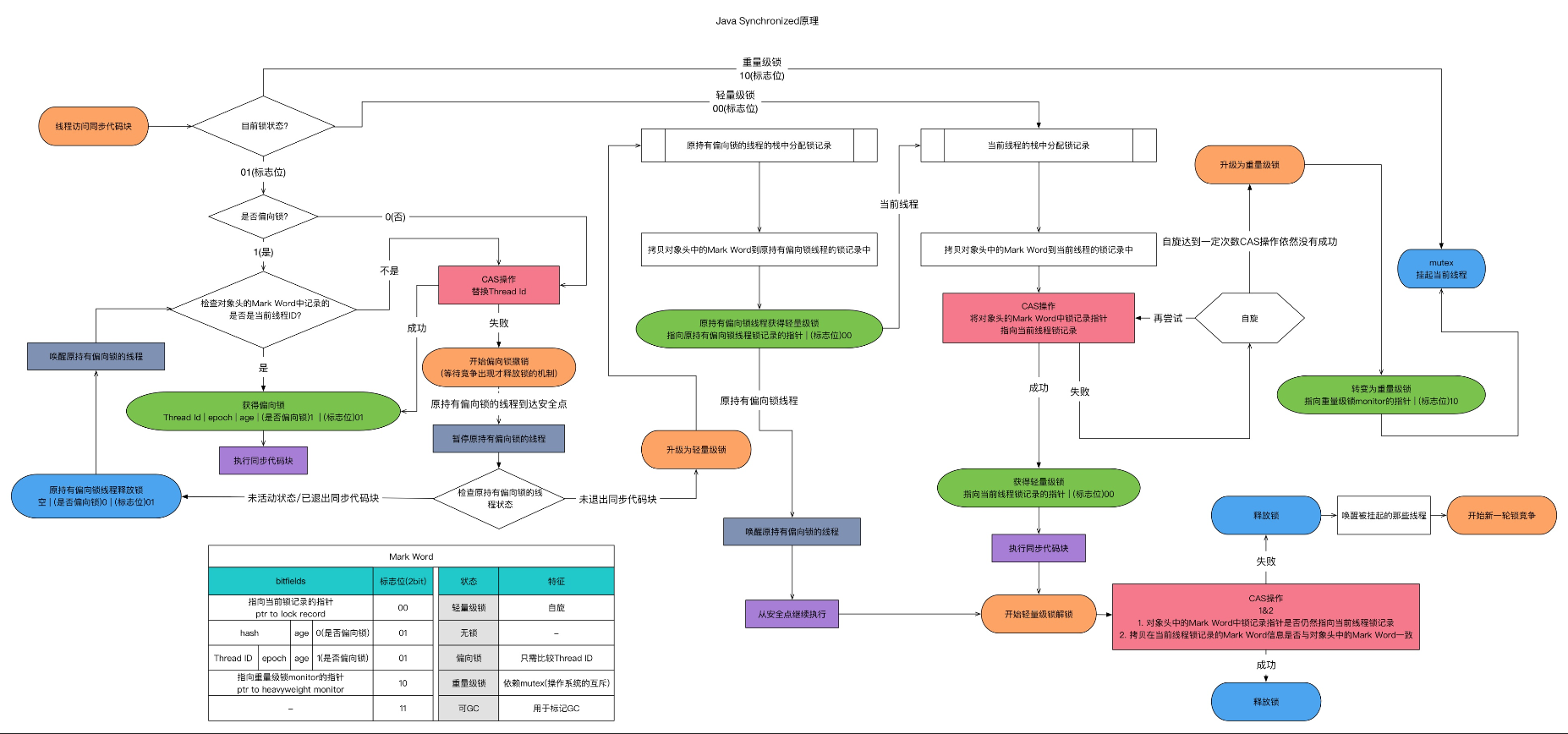
第二部分: LOCK&AQS -- 如 独占锁:ReentrantLock 读写锁:ReentrantReadWriterLock
AbstractQueuedSynchronizer(AQS) 同步框架器
并发之父 Doug Lea
Java并发编程核心在于java.concurrent.util包而juc当中的大多数同步器实现都是围绕着共同的基础行为,比如等待队列、条件队列、独占获取、共享获取等,而这个行为的抽象就是基于AbstractQueuedSynchronizer简称AQS,
AQS定义了一套多线程访问共享资源的同步器框架,是一个依赖状态(state)的同步器。
Java.concurrent.util当中同步器的实现如Lock,Latch,Barrier等,都是基于AQS框架实现
- 一般通过定义内部类Sync继承AQS
- 将同步器所有调用都映射到Sync对应的方法
AQS内部维护属性 volatile int state (32位)
- state表示资源的可用状态
State三种访问方式
- getState()、setState()、compareAndSetState()
AQS定义两种资源共享方式
- Exclusive-独占,只有一个线程能执行,如ReentrantLock
- Share-共享,多个线程可以同时执行,如Semaphore/CountDownLatch
AQS定义两种队列
- 同步等待队列 CLH对列(双向链表)
- 条件等待队列
不同的自定义同步器争用共享资源的方式也不同。自定义同步器在实现时只需要实现共享资源state的获取与释放方式即可,至于具体线程等待队列的维护(如获取资源失败入队/唤醒出队等),AQS已经在顶层实现好了。
自定义同步器实现时主要实现以下几种方法:
- isHeldExclusively():该线程是否正在独占资源。只有用到condition才需要去实现它。
- tryAcquire(int):独占方式。尝试获取资源,成功则返回true,失败则返回false。
- tryRelease(int):独占方式。尝试释放资源,成功则返回true,失败则返回false。
- tryAcquireShared(int):共享方式。尝试获取资源。负数表示失败;0表示成功,但没有剩余可用资源;正数表示成功,且有剩余资源。
- tryReleaseShared(int):共享方式。尝试释放资源,如果释放后允许唤醒后续等待结点返回true,否则返回false
AQS具备特性:
- 阻塞等待队列
- 共享/独占
- 公平/非公平
- 可重入
- 允许中断
问题 : 阻塞等待队列,是如何实现的? -- 通过魔术类 UnSafe.park() / UnSafe.unpark()
AbstractQueuedSynchronizer.java

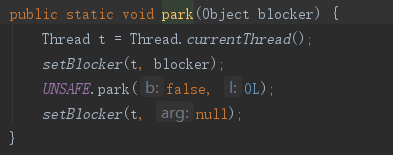
问题 : 公平和非公平锁如何实现?

公平锁: private ReentrantLock lock = new ReentrantLock(true);
非公平锁: private ReentrantLock lock = new ReentrantLock(false);
问题 : 共享锁和独占锁如何区分的?
AbstractQueuedSynchronizer.java
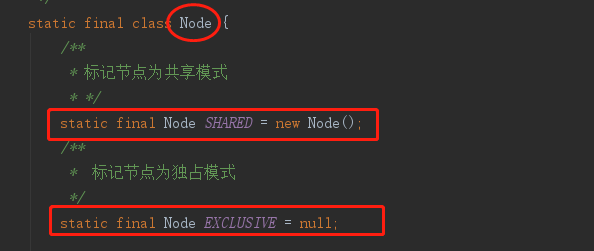
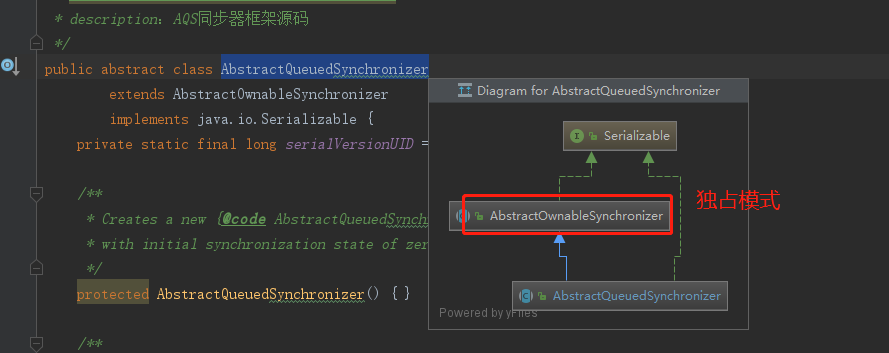
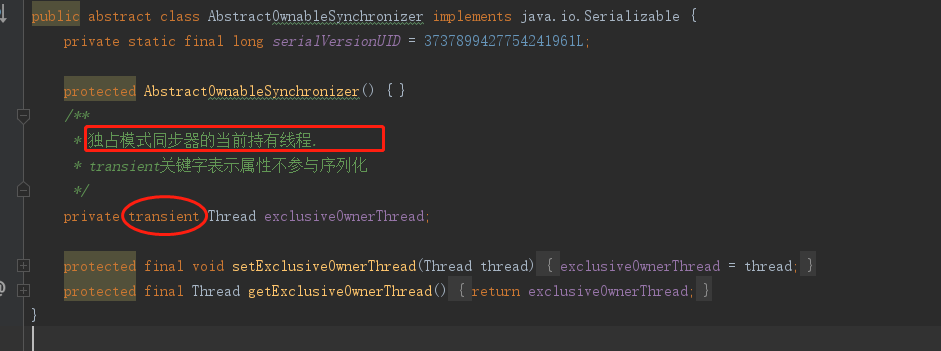
问题 : AQS定义两种资源共享方式? --- 共享 和 独占
- Exclusive -- 独占,只有一个线程能执行,如ReentrantLock
- share -- 共享,多个线程可以同时执行,如Semaphore / CountDownLatch
AQS定义的两种对列
- 同步等待队列 CLH(双向链表)
- 条件等待队列
同步等待队列详解
AQS当中的同步等待队列也称CLH队列,CLH队列是Craig、Landin、Hagersten三人发明的一种基于双向链表数据结构的队列,
是FIFO先入先出线程等待队列,Java中的CLH队列是原CLH队列的一个变种,线程由原自旋机制改为阻塞机制。

条件等待队列
Condition是一个多线程间协调通信的工具类,使得某个,或者某些线程一起等待某个条件(Condition),只有当该条件具备时,这些等待线程才会被唤醒,从而重新争夺锁。
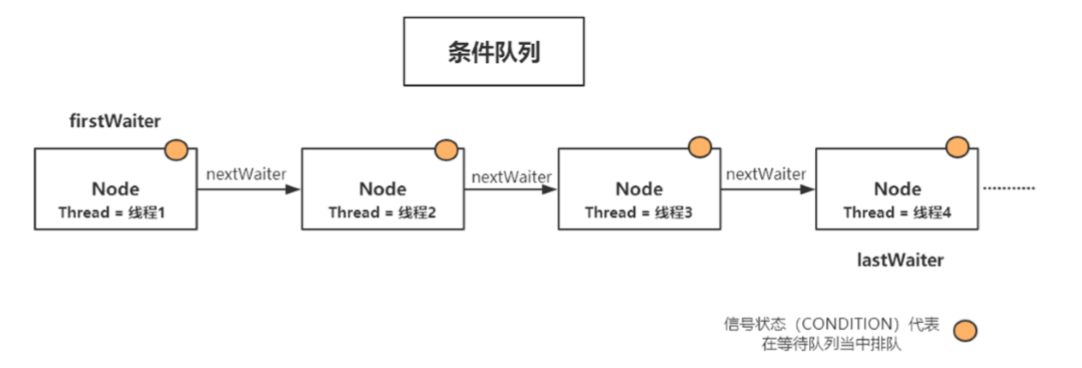
常见各种锁详解:
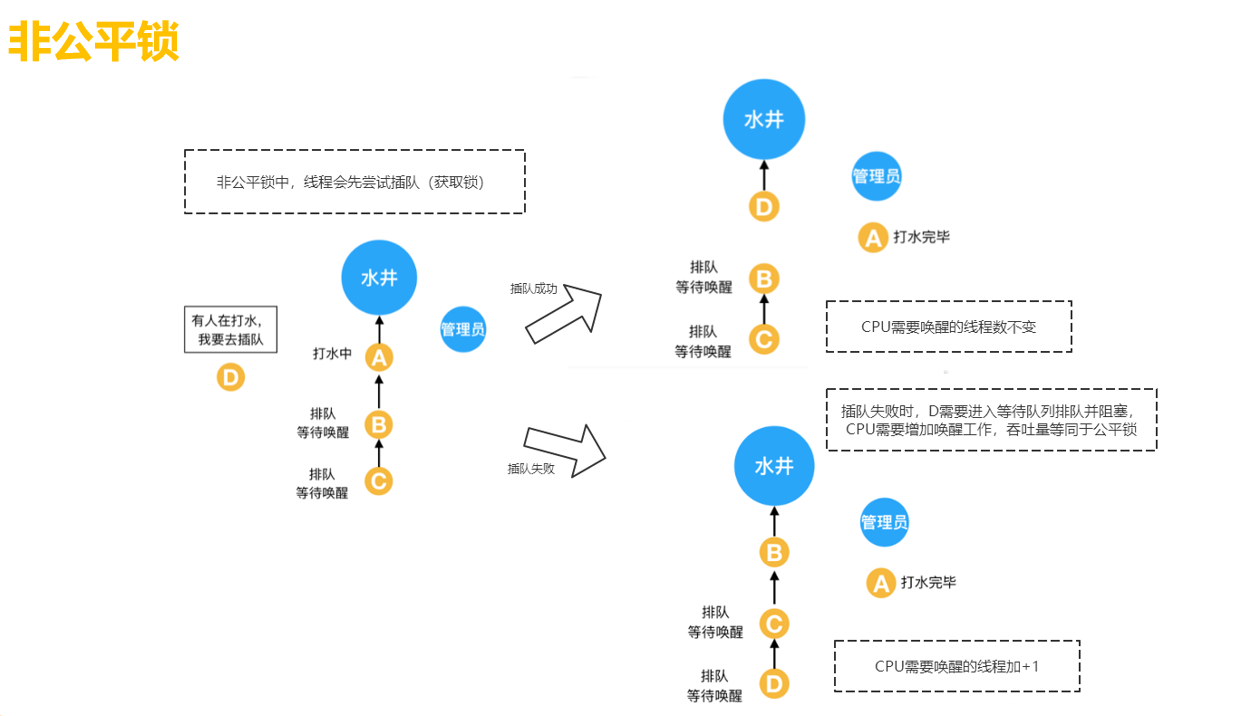
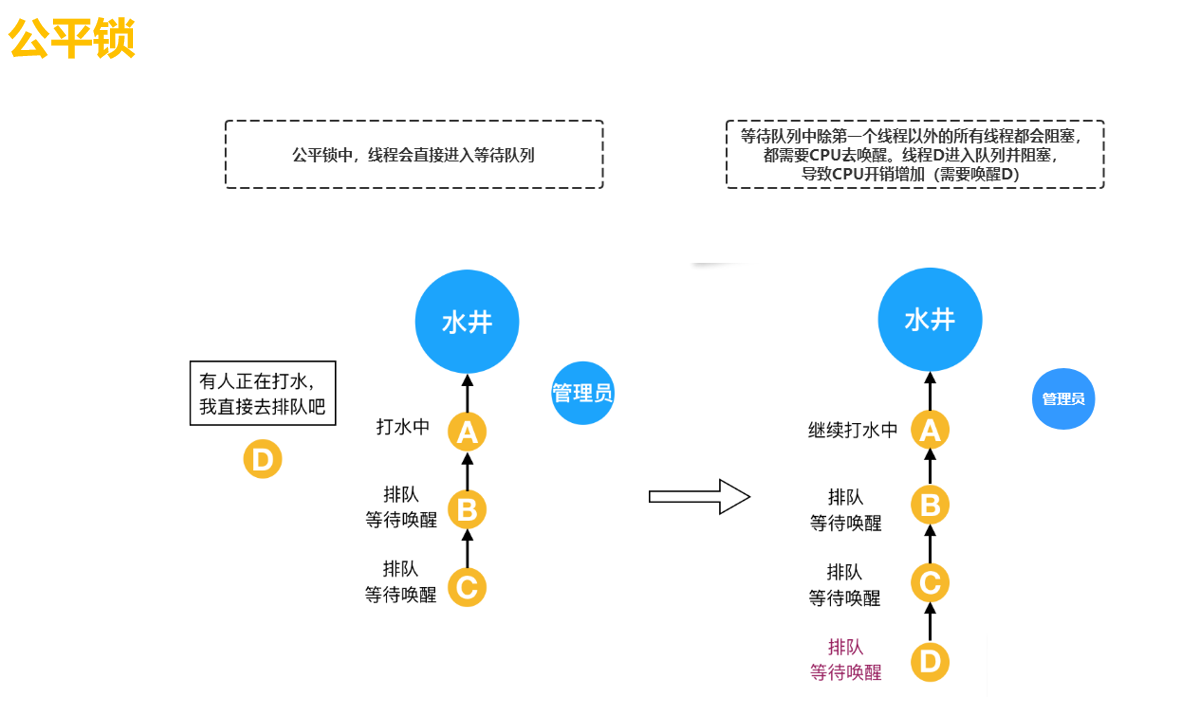
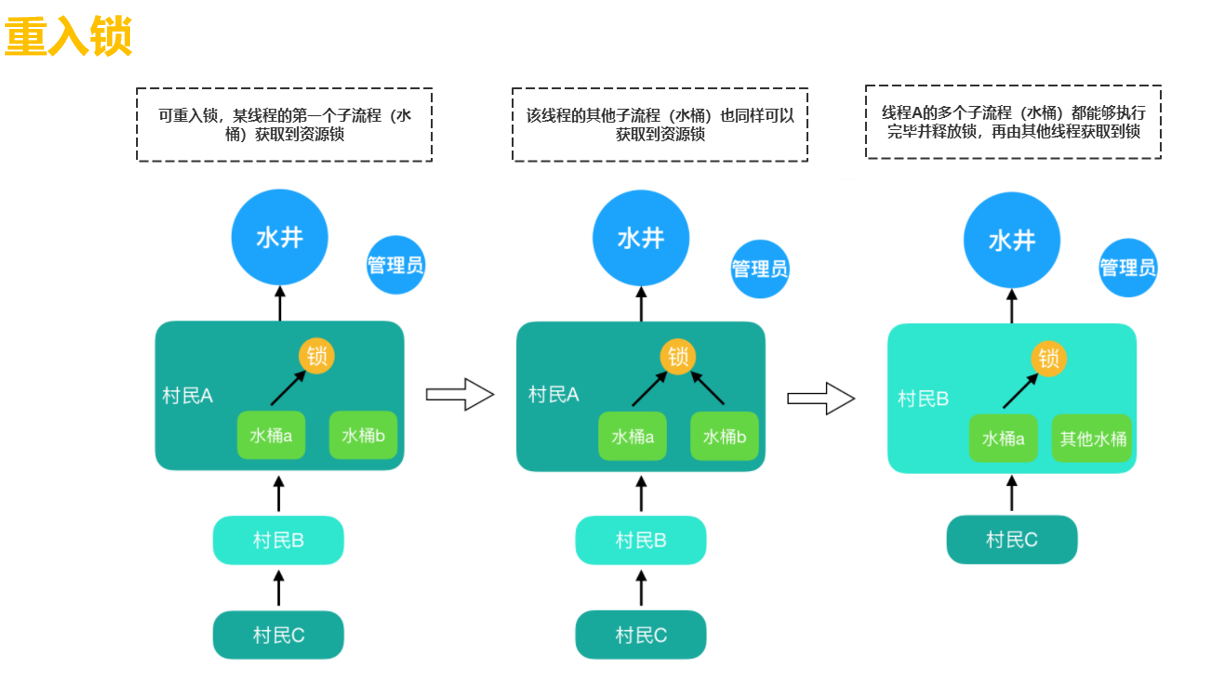
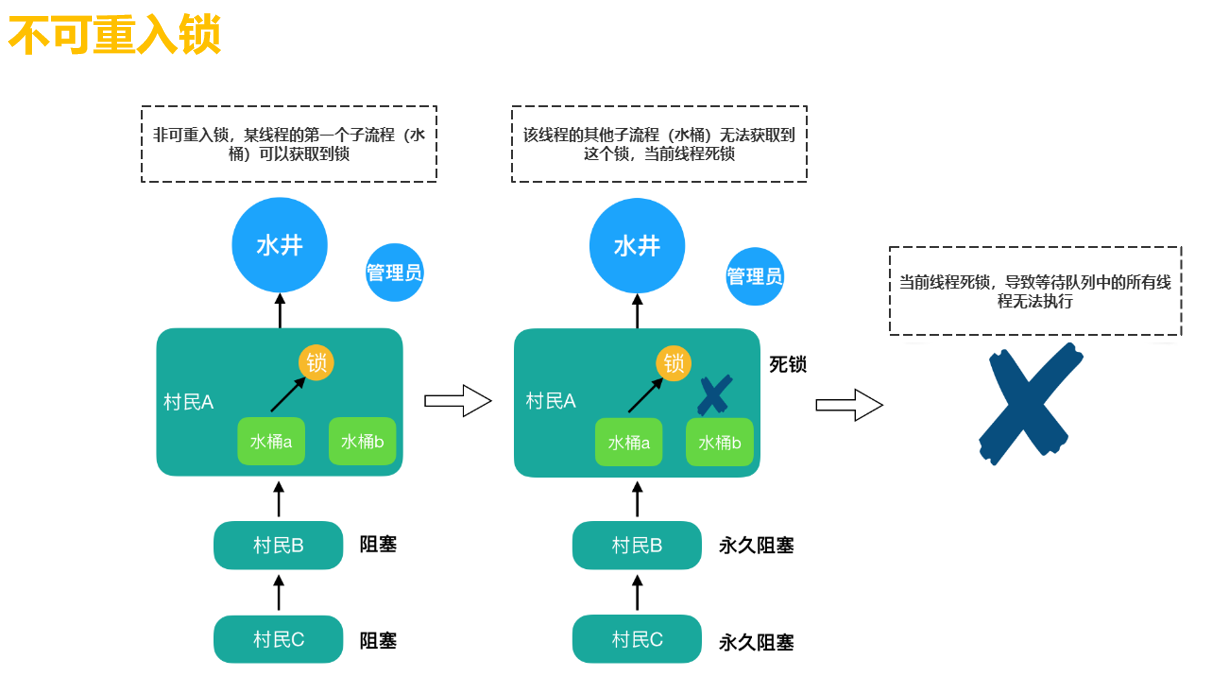
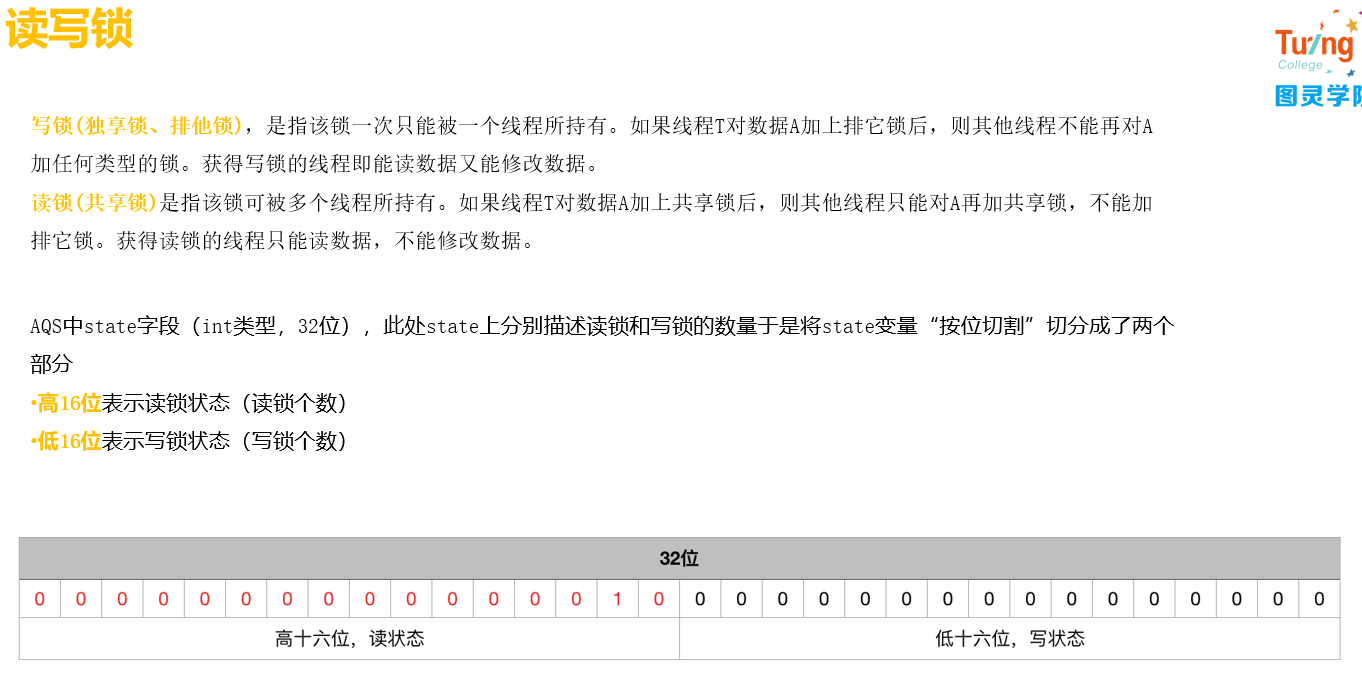
可重入锁举例:
import java.util.concurrent.locks.ReentrantLock; /** * 可重入锁 */ public class LockTemplete { private Integer counter = 0; /** * 可重入锁,公平锁 * 公平锁, * 非公平锁 * 需要保证多个线程使用的是同一个锁 * * * synchronized是否可重入? * 虚拟机,在ObjectMonitor.hpp定义了synchronized他怎么取重入加锁 ..。hotspot源码 * counter +1 * 基于AQS 去实现加锁与解锁 */ private ReentrantLock lock = new ReentrantLock(true); /** * 需要保证多个线程使用的是同一个ReentrantLock对象 * @return */ public void modifyResources(String threadName){ System.out.println("通知《管理员》线程:--->"+threadName+"准备打水"); //默认创建的是独占锁,排它锁;同一时刻读或者写只允许一个线程获取锁 lock.lock(); System.out.println("线程:--->"+threadName+"第一次加锁"); counter++; System.out.println("线程:"+threadName+"打第"+counter+"桶水"); //重入该锁,我还有一件事情要做,没做完之前不能把锁资源让出去 lock.lock(); System.out.println("线程:--->"+threadName+"第二次加锁"); counter++; System.out.println("线程:"+threadName+"打第"+counter+"桶水"); lock.unlock(); System.out.println("线程:"+threadName+"释放一个锁"); lock.unlock(); System.out.println("线程:"+threadName+"释放一个锁"); } public static void main(String[] args){ LockTemplete tp = new LockTemplete(); new Thread(()->{ String threadName = Thread.currentThread().getName(); tp.modifyResources(threadName); },"Thread A").start(); new Thread(()->{ String threadName = Thread.currentThread().getName(); tp.modifyResources(threadName); },"Thread B").start(); } }
源码解析及中文解析:
ReentrantLock.java

package com.it.edu.aqs; /* * ORACLE PROPRIETARY/CONFIDENTIAL. Use is subject to license terms. */ /* * * * * * * Written by Doug Lea with assistance from members of JCP JSR-166 * Expert Group and released to the public domain, as explained at * http://creativecommons.org/publicdomain/zero/1.0/ */ import java.util.Collection; import java.util.concurrent.TimeUnit; import java.util.concurrent.locks.Condition; import java.util.concurrent.locks.Lock; /** * A reentrant mutual exclusion {@link Lock} with the same basic * behavior and semantics as the implicit monitor lock accessed using * {@code synchronized} methods and statements, but with extended * capabilities. * * <p>A {@code ReentrantLock} is <em>owned</em> by the thread last * successfully locking, but not yet unlocking it. A thread invoking * {@code lock} will return, successfully acquiring the lock, when * the lock is not owned by another thread. The method will return * immediately if the current thread already owns the lock. This can * be checked using methods {@link #isHeldByCurrentThread}, and {@link * #getHoldCount}. * * <p>The constructor for this class accepts an optional * <em>fairness</em> parameter. When set {@code true}, under * contention, locks favor granting access to the longest-waiting * thread. Otherwise this lock does not guarantee any particular * access order. Programs using fair locks accessed by many threads * may display lower overall throughput (i.e., are slower; often much * slower) than those using the default setting, but have smaller * variances in times to obtain locks and guarantee lack of * starvation. Note however, that fairness of locks does not guarantee * fairness of thread scheduling. Thus, one of many threads using a * fair lock may obtain it multiple times in succession while other * active threads are not progressing and not currently holding the * lock. * Also note that the untimed {@link #tryLock()} method does not * honor the fairness setting. It will succeed if the lock * is available even if other threads are waiting. * * <p>It is recommended practice to <em>always</em> immediately * follow a call to {@code lock} with a {@code try} block, most * typically in a before/after construction such as: * * <pre> {@code * class X { * private final ReentrantLock lock = new ReentrantLock(); * // ... * * public void m() { * lock.lock(); // block until condition holds * try { * // ... method body * } finally { * lock.unlock() * } * } * }}</pre> * * <p>In addition to implementing the {@link Lock} interface, this * class defines a number of {@code public} and {@code protected} * methods for inspecting the state of the lock. Some of these * methods are only useful for instrumentation and monitoring. * * <p>Serialization of this class behaves in the same way as built-in * locks: a deserialized lock is in the unlocked state, regardless of * its state when serialized. * * <p>This lock supports a maximum of 2147483647 recursive locks by * the same thread. Attempts to exceed this limit result in * {@link Error} throws from locking methods. * * @since 1.5 * @author Doug Lea */ public class ReentrantLock implements Lock, java.io.Serializable { private static final long serialVersionUID = 7373984872572414699L; /** * 内部调用AQS的动作,都基于该成员属性实现 */ private final Sync sync; /** * ReentrantLock锁同步操作的基础类Sync,继承自AQS框架. * 该类有两个继承类,1、NonfairSync 非公平锁,2、FairSync公平锁 */ abstract static class Sync extends AbstractQueuedSynchronizer { private static final long serialVersionUID = -5179523762034025860L; /** * 加锁的具体行为由子类实现 */ abstract void lock(); /** * 尝试获取非公平锁 */ final boolean nonfairTryAcquire(int acquires) { //acquires = 1 final Thread current = Thread.currentThread(); int c = getState(); /** * 不需要判断同步队列(CLH)中是否有排队等待线程 * 判断state状态是否为0,不为0可以加锁 */ if (c == 0) { //unsafe操作,cas修改state状态 if (compareAndSetState(0, acquires)) { //独占状态锁持有者指向当前线程 setExclusiveOwnerThread(current); return true; } } /** * state状态不为0,判断锁持有者是否是当前线程, * 如果是当前线程持有 则state+1 */ else if (current == getExclusiveOwnerThread()) { int nextc = c + acquires; if (nextc < 0) // overflow throw new Error("Maximum lock count exceeded"); setState(nextc); return true; } //加锁失败 return false; } /** * 释放锁 */ protected final boolean tryRelease(int releases) { int c = getState() - releases; if (Thread.currentThread() != getExclusiveOwnerThread()) throw new IllegalMonitorStateException(); boolean free = false; if (c == 0) { free = true; setExclusiveOwnerThread(null); } setState(c); return free; } /** * 判断持有独占锁的线程是否是当前线程 */ protected final boolean isHeldExclusively() { return getExclusiveOwnerThread() == Thread.currentThread(); } //返回条件对象 final ConditionObject newCondition() { return new ConditionObject(); } final Thread getOwner() { return getState() == 0 ? null : getExclusiveOwnerThread(); } final int getHoldCount() { return isHeldExclusively() ? getState() : 0; } final boolean isLocked() { return getState() != 0; } /** * Reconstitutes the instance from a stream (that is, deserializes it). */ private void readObject(java.io.ObjectInputStream s) throws java.io.IOException, ClassNotFoundException { s.defaultReadObject(); setState(0); // reset to unlocked state } } /** * 非公平锁 */ static final class NonfairSync extends Sync { private static final long serialVersionUID = 7316153563782823691L; /** * 加锁行为 */ final void lock() { /** * 第一步:直接尝试加锁 * 与公平锁实现的加锁行为一个最大的区别在于,此处不会去判断同步队列(CLH队列)中 * 是否有排队等待加锁的节点,上来直接加锁(判断state是否为0,CAS修改state为1) * ,并将独占锁持有者 exclusiveOwnerThread 属性指向当前线程 * 如果当前有人占用锁,再尝试去加一次锁 */ if (compareAndSetState(0, 1)) setExclusiveOwnerThread(Thread.currentThread()); else //AQS定义的方法,加锁 acquire(1); } /** * 父类AbstractQueuedSynchronizer.acquire()中调用本方法 */ protected final boolean tryAcquire(int acquires) { return nonfairTryAcquire(acquires); } } /** * 公平锁 */ static final class FairSync extends Sync { private static final long serialVersionUID = -3000897897090466540L; final void lock() { acquire(1); } /** * 重写aqs中的方法逻辑 * 尝试加锁,被AQS的acquire()方法调用 */ protected final boolean tryAcquire(int acquires) { final Thread current = Thread.currentThread(); int c = getState(); if (c == 0) { /** * 与非公平锁中的区别,需要先判断队列当中是否有等待的节点 * 如果没有则可以尝试CAS获取锁 */ if (!hasQueuedPredecessors() && compareAndSetState(0, acquires)) { //独占线程指向当前线程 setExclusiveOwnerThread(current); return true; } } else if (current == getExclusiveOwnerThread()) { int nextc = c + acquires; if (nextc < 0) throw new Error("Maximum lock count exceeded"); setState(nextc); return true; } return false; } } /** * 默认构造函数,创建非公平锁对象 */ public ReentrantLock() { sync = new NonfairSync(); } /** * 根据要求创建公平锁或非公平锁 */ public ReentrantLock(boolean fair) { sync = fair ? new FairSync() : new NonfairSync(); } /** * 加锁 */ public void lock() { sync.lock(); } /** * 尝试获去取锁,获取失败被阻塞,线程被中断直接抛出异常 */ public void lockInterruptibly() throws InterruptedException { sync.acquireInterruptibly(1); } /** * 尝试加锁 */ public boolean tryLock() { return sync.nonfairTryAcquire(1); } /** * 指定等待时间内尝试加锁 */ public boolean tryLock(long timeout, TimeUnit unit) throws InterruptedException { return sync.tryAcquireNanos(1, unit.toNanos(timeout)); } /** * 尝试去释放锁 */ public void unlock() { sync.release(1); } /** * 返回条件对象 */ public Condition newCondition() { return sync.newCondition(); } /** * 返回当前线程持有的state状态数量 */ public int getHoldCount() { return sync.getHoldCount(); } /** * 查询当前线程是否持有锁 */ public boolean isHeldByCurrentThread() { return sync.isHeldExclusively(); } /** * 状态表示是否被Thread加锁持有 */ public boolean isLocked() { return sync.isLocked(); } /** * 是否公平锁?是返回true 否则返回 false */ public final boolean isFair() { return sync instanceof FairSync; } /** * Returns the thread that currently owns this lock, or * {@code null} if not owned. When this method is called by a * thread that is not the owner, the return value reflects a * best-effort approximation of current lock status. For example, * the owner may be momentarily {@code null} even if there are * threads trying to acquire the lock but have not yet done so. * This method is designed to facilitate construction of * subclasses that provide more extensive lock monitoring * facilities. * * @return the owner, or {@code null} if not owned */ protected Thread getOwner() { return sync.getOwner(); } /** * 判断队列当中是否有在等待获取锁的Thread节点 */ public final boolean hasQueuedThreads() { return sync.hasQueuedThreads(); } /** * 当前线程是否在同步队列中等待 */ public final boolean hasQueuedThread(Thread thread) { return sync.isQueued(thread); } /** * Returns an estimate of the number of threads waiting to * acquire this lock. The value is only an estimate because the number of * threads may change dynamically while this method traverses * internal data structures. This method is designed for use in * monitoring of the system state, not for synchronization * control. * * @return the estimated number of threads waiting for this lock */ public final int getQueueLength() { return sync.getQueueLength(); } /** * 返回Thread集合,排队中的所有节点Thread会被返回 */ protected Collection<Thread> getQueuedThreads() { return sync.getQueuedThreads(); } /** * 条件队列当中是否有正在等待的节点 */ public boolean hasWaiters(Condition condition) { if (condition == null) throw new NullPointerException(); if (!(condition instanceof AbstractQueuedSynchronizer.ConditionObject)) throw new IllegalArgumentException("not owner"); return sync.hasWaiters((AbstractQueuedSynchronizer.ConditionObject)condition); } /** * Returns an estimate of the number of threads waiting on the * given condition associated with this lock. Note that because * timeouts and interrupts may occur at any time, the estimate * serves only as an upper bound on the actual number of waiters. * This method is designed for use in monitoring of the system * state, not for synchronization control. * * @param condition the condition * @return the estimated number of waiting threads * @throws IllegalMonitorStateException if this lock is not held * @throws IllegalArgumentException if the given condition is * not associated with this lock * @throws NullPointerException if the condition is null */ public int getWaitQueueLength(Condition condition) { if (condition == null) throw new NullPointerException(); if (!(condition instanceof AbstractQueuedSynchronizer.ConditionObject)) throw new IllegalArgumentException("not owner"); return sync.getWaitQueueLength((AbstractQueuedSynchronizer.ConditionObject)condition); } /** * Returns a collection containing those threads that may be * waiting on the given condition associated with this lock. * Because the actual set of threads may change dynamically while * constructing this result, the returned collection is only a * best-effort estimate. The elements of the returned collection * are in no particular order. This method is designed to * facilitate construction of subclasses that provide more * extensive condition monitoring facilities. * * @param condition the condition * @return the collection of threads * @throws IllegalMonitorStateException if this lock is not held * @throws IllegalArgumentException if the given condition is * not associated with this lock * @throws NullPointerException if the condition is null */ protected Collection<Thread> getWaitingThreads(Condition condition) { if (condition == null) throw new NullPointerException(); if (!(condition instanceof AbstractQueuedSynchronizer.ConditionObject)) throw new IllegalArgumentException("not owner"); return sync.getWaitingThreads((AbstractQueuedSynchronizer.ConditionObject)condition); } /** * Returns a string identifying this lock, as well as its lock state. * The state, in brackets, includes either the String {@code "Unlocked"} * or the String {@code "Locked by"} followed by the * {@linkplain Thread#getName name} of the owning thread. * * @return a string identifying this lock, as well as its lock state */ public String toString() { Thread o = sync.getOwner(); return super.toString() + ((o == null) ? "[Unlocked]" : "[Locked by thread " + o.getName() + "]"); } }
ReentrantReadWriteLock.java

/* * ORACLE PROPRIETARY/CONFIDENTIAL. Use is subject to license terms. * * * * * * * * * * * * * * * * * * * * */ /* * * * * * * Written by Doug Lea with assistance from members of JCP JSR-166 * Expert Group and released to the public domain, as explained at * http://creativecommons.org/publicdomain/zero/1.0/ */ package com.it.edu.aqs; import java.util.concurrent.TimeUnit; import java.util.Collection; import java.util.concurrent.locks.Condition; import java.util.concurrent.locks.Lock; import java.util.concurrent.locks.ReadWriteLock; /** * An implementation of {@link ReadWriteLock} supporting similar * semantics to {@link ReentrantLock}. * <p>This class has the following properties: * * <ul> * <li><b>Acquisition order</b> * * <p>This class does not impose a reader or writer preference * ordering for lock access. However, it does support an optional * <em>fairness</em> policy. * * <dl> * <dt><b><i>Non-fair mode (default)</i></b> * <dd>When constructed as non-fair (the default), the order of entry * to the read and write lock is unspecified, subject to reentrancy * constraints. A nonfair lock that is continuously contended may * indefinitely postpone one or more reader or writer threads, but * will normally have higher throughput than a fair lock. * * <dt><b><i>Fair mode</i></b> * <dd>When constructed as fair, threads contend for entry using an * approximately arrival-order policy. When the currently held lock * is released, either the longest-waiting single writer thread will * be assigned the write lock, or if there is a group of reader threads * waiting longer than all waiting writer threads, that group will be * assigned the read lock. * * <p>A thread that tries to acquire a fair read lock (non-reentrantly) * will block if either the write lock is held, or there is a waiting * writer thread. The thread will not acquire the read lock until * after the oldest currently waiting writer thread has acquired and * released the write lock. Of course, if a waiting writer abandons * its wait, leaving one or more reader threads as the longest waiters * in the queue with the write lock free, then those readers will be * assigned the read lock. * * <p>A thread that tries to acquire a fair write lock (non-reentrantly) * will block unless both the read lock and write lock are free (which * implies there are no waiting threads). (Note that the non-blocking * {@link ReadLock#tryLock()} and {@link WriteLock#tryLock()} methods * do not honor this fair setting and will immediately acquire the lock * if it is possible, regardless of waiting threads.) * <p> * </dl> * * <li><b>Reentrancy</b> * * <p>This lock allows both readers and writers to reacquire read or * write locks in the style of a {@link ReentrantLock}. Non-reentrant * readers are not allowed until all write locks held by the writing * thread have been released. * * <p>Additionally, a writer can acquire the read lock, but not * vice-versa. Among other applications, reentrancy can be useful * when write locks are held during calls or callbacks to methods that * perform reads under read locks. If a reader tries to acquire the * write lock it will never succeed. * * <li><b>Lock downgrading</b> * <p>Reentrancy also allows downgrading from the write lock to a read lock, * by acquiring the write lock, then the read lock and then releasing the * write lock. However, upgrading from a read lock to the write lock is * <b>not</b> possible. * * <li><b>Interruption of lock acquisition</b> * <p>The read lock and write lock both support interruption during lock * acquisition. * * <li><b>{@link Condition} support</b> * <p>The write lock provides a {@link Condition} implementation that * behaves in the same way, with respect to the write lock, as the * {@link Condition} implementation provided by * {@link ReentrantLock#newCondition} does for {@link ReentrantLock}. * This {@link Condition} can, of course, only be used with the write lock. * * <p>The read lock does not support a {@link Condition} and * {@code readLock().newCondition()} throws * {@code UnsupportedOperationException}. * * <li><b>Instrumentation</b> * <p>This class supports methods to determine whether locks * are held or contended. These methods are designed for monitoring * system state, not for synchronization control. * </ul> * * <p>Serialization of this class behaves in the same way as built-in * locks: a deserialized lock is in the unlocked state, regardless of * its state when serialized. * * <p><b>Sample usages</b>. Here is a code sketch showing how to perform * lock downgrading after updating a cache (exception handling is * particularly tricky when handling multiple locks in a non-nested * fashion): * * <pre> {@code * class CachedData { * Object data; * volatile boolean cacheValid; * final ReentrantReadWriteLock rwl = new ReentrantReadWriteLock(); * * void processCachedData() { * rwl.readLock().lock(); * if (!cacheValid) { * // Must release read lock before acquiring write lock * rwl.readLock().unlock(); * rwl.writeLock().lock(); * try { * // Recheck state because another thread might have * // acquired write lock and changed state before we did. * if (!cacheValid) { * data = ... * cacheValid = true; * } * // Downgrade by acquiring read lock before releasing write lock * rwl.readLock().lock(); * } finally { * rwl.writeLock().unlock(); // Unlock write, still hold read * } * } * * try { * use(data); * } finally { * rwl.readLock().unlock(); * } * } * }}</pre> * * ReentrantReadWriteLocks can be used to improve concurrency in some * uses of some kinds of Collections. This is typically worthwhile * only when the collections are expected to be large, accessed by * more reader threads than writer threads, and entail operations with * overhead that outweighs synchronization overhead. For example, here * is a class using a TreeMap that is expected to be large and * concurrently accessed. * * <pre> {@code * class RWDictionary { * private final Map<String, Data> m = new TreeMap<String, Data>(); * private final ReentrantReadWriteLock rwl = new ReentrantReadWriteLock(); * private final Lock r = rwl.readLock(); * private final Lock w = rwl.writeLock(); * * public Data get(String key) { * r.lock(); * try { return m.get(key); } * finally { r.unlock(); } * } * public String[] allKeys() { * r.lock(); * try { return m.keySet().toArray(); } * finally { r.unlock(); } * } * public Data put(String key, Data value) { * w.lock(); * try { return m.put(key, value); } * finally { w.unlock(); } * } * public void clear() { * w.lock(); * try { m.clear(); } * finally { w.unlock(); } * } * }}</pre> * * <h3>Implementation Notes</h3> * * <p>This lock supports a maximum of 65535 recursive write locks * and 65535 read locks. Attempts to exceed these limits result in * {@link Error} throws from locking methods. * * @since 1.5 * @author Doug Lea */ public class ReentrantReadWriteLock implements ReadWriteLock, java.io.Serializable { private static final long serialVersionUID = -6992448646407690164L; /** Inner class providing readlock */ private final ReentrantReadWriteLock.ReadLock readerLock; /** Inner class providing writelock */ private final ReentrantReadWriteLock.WriteLock writerLock; /** Performs all synchronization mechanics */ final Sync sync; /** * Creates a new {@code ReentrantReadWriteLock} with * default (nonfair) ordering properties. */ public ReentrantReadWriteLock() { this(false); } /** * Creates a new {@code ReentrantReadWriteLock} with * the given fairness policy. * * @param fair {@code true} if this lock should use a fair ordering policy */ public ReentrantReadWriteLock(boolean fair) { sync = fair ? new FairSync() : new NonfairSync(); readerLock = new ReadLock(this); writerLock = new WriteLock(this); } public ReentrantReadWriteLock.WriteLock writeLock() { return writerLock; } public ReentrantReadWriteLock.ReadLock readLock() { return readerLock; } /** * Synchronization implementation for ReentrantReadWriteLock. * Subclassed into fair and nonfair versions. */ abstract static class Sync extends AbstractQueuedSynchronizer { private static final long serialVersionUID = 6317671515068378041L; /* * Read vs write count extraction constants and functions. * Lock state is logically divided into two unsigned shorts: * The lower one representing the exclusive (writer) lock hold count, * and the upper the shared (reader) hold count. */ static final int SHARED_SHIFT = 16; static final int SHARED_UNIT = (1 << SHARED_SHIFT); static final int MAX_COUNT = (1 << SHARED_SHIFT) - 1; static final int EXCLUSIVE_MASK = (1 << SHARED_SHIFT) - 1; /** Returns the number of shared holds represented in count */ static int sharedCount(int c) { return c >>> SHARED_SHIFT; } /** Returns the number of exclusive holds represented in count */ static int exclusiveCount(int c) { return c & EXCLUSIVE_MASK; } /** * A counter for per-thread read hold counts. * Maintained as a ThreadLocal; cached in cachedHoldCounter */ static final class HoldCounter { int count = 0; // Use id, not reference, to avoid garbage retention final long tid = getThreadId(Thread.currentThread()); } /** * ThreadLocal subclass. Easiest to explicitly define for sake * of deserialization mechanics. */ static final class ThreadLocalHoldCounter extends ThreadLocal<HoldCounter> { public HoldCounter initialValue() { return new HoldCounter(); } } /** * The number of reentrant read locks held by current thread. * Initialized only in constructor and readObject. * Removed whenever a thread's read hold count drops to 0. */ private transient ThreadLocalHoldCounter readHolds; /** * The hold count of the last thread to successfully acquire * readLock. This saves ThreadLocal lookup in the common case * where the next thread to release is the last one to * acquire. This is non-volatile since it is just used * as a heuristic, and would be great for threads to cache. * * <p>Can outlive the Thread for which it is caching the read * hold count, but avoids garbage retention by not retaining a * reference to the Thread. * * <p>Accessed via a benign data race; relies on the memory * model's final field and out-of-thin-air guarantees. */ private transient HoldCounter cachedHoldCounter; /** * firstReader is the first thread to have acquired the read lock. * firstReaderHoldCount is firstReader's hold count. * * <p>More precisely, firstReader is the unique thread that last * changed the shared count from 0 to 1, and has not released the * read lock since then; null if there is no such thread. * * <p>Cannot cause garbage retention unless the thread terminated * without relinquishing its read locks, since tryReleaseShared * sets it to null. * * <p>Accessed via a benign data race; relies on the memory * model's out-of-thin-air guarantees for references. * * <p>This allows tracking of read holds for uncontended read * locks to be very cheap. */ private transient Thread firstReader = null; private transient int firstReaderHoldCount; Sync() { readHolds = new ThreadLocalHoldCounter(); setState(getState()); // ensures visibility of readHolds } /* * Acquires and releases use the same code for fair and * nonfair locks, but differ in whether/how they allow barging * when queues are non-empty. */ /** * Returns true if the current thread, when trying to acquire * the read lock, and otherwise eligible to do so, should block * because of policy for overtaking other waiting threads. */ abstract boolean readerShouldBlock(); /** * Returns true if the current thread, when trying to acquire * the write lock, and otherwise eligible to do so, should block * because of policy for overtaking other waiting threads. */ abstract boolean writerShouldBlock(); /* * Note that tryRelease and tryAcquire can be called by * Conditions. So it is possible that their arguments contain * both read and write holds that are all released during a * condition wait and re-established in tryAcquire. */ protected final boolean tryRelease(int releases) { if (!isHeldExclusively()) throw new IllegalMonitorStateException(); int nextc = getState() - releases; boolean free = exclusiveCount(nextc) == 0; if (free) setExclusiveOwnerThread(null); setState(nextc); return free; } protected final boolean tryAcquire(int acquires) { /* * Walkthrough: * 1. If read count nonzero or write count nonzero * and owner is a different thread, fail. * 2. If count would saturate, fail. (This can only * happen if count is already nonzero.) * 3. Otherwise, this thread is eligible for lock if * it is either a reentrant acquire or * queue policy allows it. If so, update state * and set owner. */ Thread current = Thread.currentThread(); int c = getState(); int w = exclusiveCount(c); if (c != 0) { // (Note: if c != 0 and w == 0 then shared count != 0) if (w == 0 || current != getExclusiveOwnerThread()) return false; if (w + exclusiveCount(acquires) > MAX_COUNT) throw new Error("Maximum lock count exceeded"); // Reentrant acquire setState(c + acquires); return true; } if (writerShouldBlock() || !compareAndSetState(c, c + acquires)) return false; setExclusiveOwnerThread(current); return true; } /** * 重写aqs当中业务逻辑 * @param unused * @return */ protected final boolean tryReleaseShared(int unused) { Thread current = Thread.currentThread(); if (firstReader == current) { // assert firstReaderHoldCount > 0; if (firstReaderHoldCount == 1) firstReader = null; else firstReaderHoldCount--; } else { HoldCounter rh = cachedHoldCounter; if (rh == null || rh.tid != getThreadId(current)) rh = readHolds.get(); int count = rh.count; if (count <= 1) { readHolds.remove(); if (count <= 0) throw unmatchedUnlockException(); } --rh.count; } for (;;) { int c = getState(); int nextc = c - SHARED_UNIT; if (compareAndSetState(c, nextc)) // Releasing the read lock has no effect on readers, // but it may allow waiting writers to proceed if // both read and write locks are now free. return nextc == 0; } } private IllegalMonitorStateException unmatchedUnlockException() { return new IllegalMonitorStateException( "attempt to unlock read lock, not locked by current thread"); } /** * 尝试加共享锁 */ protected final int tryAcquireShared(int unused) { Thread current = Thread.currentThread(); int c = getState(); /** * 如果state状态当前被加独占写锁,则返回加共享锁失败 */ if (exclusiveCount(c) != 0 && getExclusiveOwnerThread() != current) return -1; int r = sharedCount(c); //读锁数量 if (!readerShouldBlock() && //读锁是否应该阻塞 r < MAX_COUNT && compareAndSetState(c, c + SHARED_UNIT)) { if (r == 0) { //第一次加读锁 firstReader = current; firstReaderHoldCount = 1;//第一个读锁Thread持有锁数量 } else if (firstReader == current) { firstReaderHoldCount++; //当前Thread是加锁,读锁数量加1 } else { HoldCounter rh = cachedHoldCounter; if (rh == null || rh.tid != getThreadId(current)) //每一个加锁的thread对应一个HoldCounter cachedHoldCounter = rh = readHolds.get();//从threadLocal中取出变量 else if (rh.count == 0) readHolds.set(rh); rh.count++;// } return 1; } return fullTryAcquireShared(current); } /** * Full version of acquire for reads, that handles CAS misses * and reentrant reads not dealt with in tryAcquireShared. */ final int fullTryAcquireShared(Thread current) { /* * This code is in part redundant with that in * tryAcquireShared but is simpler overall by not * complicating tryAcquireShared with interactions between * retries and lazily reading hold counts. */ HoldCounter rh = null; for (;;) { int c = getState(); if (exclusiveCount(c) != 0) { if (getExclusiveOwnerThread() != current) return -1; // else we hold the exclusive lock; blocking here // would cause deadlock. } else if (readerShouldBlock()) { // Make sure we're not acquiring read lock reentrantly if (firstReader == current) { // assert firstReaderHoldCount > 0; } else { if (rh == null) { rh = cachedHoldCounter; if (rh == null || rh.tid != getThreadId(current)) { rh = readHolds.get(); if (rh.count == 0) readHolds.remove(); } } if (rh.count == 0) return -1; } } if (sharedCount(c) == MAX_COUNT) throw new Error("Maximum lock count exceeded"); if (compareAndSetState(c, c + SHARED_UNIT)) { if (sharedCount(c) == 0) { firstReader = current; firstReaderHoldCount = 1; } else if (firstReader == current) { firstReaderHoldCount++; } else { if (rh == null) rh = cachedHoldCounter; if (rh == null || rh.tid != getThreadId(current)) rh = readHolds.get(); else if (rh.count == 0) readHolds.set(rh); rh.count++; cachedHoldCounter = rh; // cache for release } return 1; } } } /** * Performs tryLock for write, enabling barging in both modes. * This is identical in effect to tryAcquire except for lack * of calls to writerShouldBlock. */ final boolean tryWriteLock() { Thread current = Thread.currentThread(); int c = getState(); if (c != 0) { int w = exclusiveCount(c); if (w == 0 || current != getExclusiveOwnerThread()) return false; if (w == MAX_COUNT) throw new Error("Maximum lock count exceeded"); } if (!compareAndSetState(c, c + 1)) return false; setExclusiveOwnerThread(current); return true; } /** * Performs tryLock for read, enabling barging in both modes. * This is identical in effect to tryAcquireShared except for * lack of calls to readerShouldBlock. */ final boolean tryReadLock() { Thread current = Thread.currentThread(); for (;;) { int c = getState(); if (exclusiveCount(c) != 0 && getExclusiveOwnerThread() != current) return false; int r = sharedCount(c); if (r == MAX_COUNT) throw new Error("Maximum lock count exceeded"); if (compareAndSetState(c, c + SHARED_UNIT)) { if (r == 0) { firstReader = current; firstReaderHoldCount = 1; } else if (firstReader == current) { firstReaderHoldCount++; } else { HoldCounter rh = cachedHoldCounter; if (rh == null || rh.tid != getThreadId(current)) cachedHoldCounter = rh = readHolds.get(); else if (rh.count == 0) readHolds.set(rh); rh.count++; } return true; } } } protected final boolean isHeldExclusively() { // While we must in general read state before owner, // we don't need to do so to check if current thread is owner return getExclusiveOwnerThread() == Thread.currentThread(); } // Methods relayed to outer class final ConditionObject newCondition() { return new ConditionObject(); } final Thread getOwner() { // Must read state before owner to ensure memory consistency return ((exclusiveCount(getState()) == 0) ? null : getExclusiveOwnerThread()); } final int getReadLockCount() { return sharedCount(getState()); } final boolean isWriteLocked() { return exclusiveCount(getState()) != 0; } final int getWriteHoldCount() { return isHeldExclusively() ? exclusiveCount(getState()) : 0; } final int getReadHoldCount() { if (getReadLockCount() == 0) return 0; Thread current = Thread.currentThread(); if (firstReader == current) return firstReaderHoldCount; HoldCounter rh = cachedHoldCounter; if (rh != null && rh.tid == getThreadId(current)) return rh.count; int count = readHolds.get().count; if (count == 0) readHolds.remove(); return count; } /** * Reconstitutes the instance from a stream (that is, deserializes it). */ private void readObject(java.io.ObjectInputStream s) throws java.io.IOException, ClassNotFoundException { s.defaultReadObject(); readHolds = new ThreadLocalHoldCounter(); setState(0); // reset to unlocked state } final int getCount() { return getState(); } } /** * Nonfair version of Sync */ static final class NonfairSync extends Sync { private static final long serialVersionUID = -8159625535654395037L; final boolean writerShouldBlock() { return false; // writers can always barge } final boolean readerShouldBlock() { /* As a heuristic to avoid indefinite writer starvation, * block if the thread that momentarily appears to be head * of queue, if one exists, is a waiting writer. This is * only a probabilistic effect since a new reader will not * block if there is a waiting writer behind other enabled * readers that have not yet drained from the queue. */ return apparentlyFirstQueuedIsExclusive(); } } /** * Fair version of Sync */ static final class FairSync extends Sync { private static final long serialVersionUID = -2274990926593161451L; final boolean writerShouldBlock() { return hasQueuedPredecessors(); } final boolean readerShouldBlock() { return hasQueuedPredecessors(); } } /** * The lock returned by method {@link ReentrantReadWriteLock#readLock}. */ public static class ReadLock implements Lock, java.io.Serializable { private static final long serialVersionUID = -5992448646407690164L; private final Sync sync; /** * Constructor for use by subclasses * * @param lock the outer lock object * @throws NullPointerException if the lock is null */ protected ReadLock(ReentrantReadWriteLock lock) { sync = lock.sync; } /** * Acquires the read lock. * * <p>Acquires the read lock if the write lock is not held by * another thread and returns immediately. * * <p>If the write lock is held by another thread then * the current thread becomes disabled for thread scheduling * purposes and lies dormant until the read lock has been acquired. */ public void lock() { sync.acquireShared(1); } /** * Acquires the read lock unless the current thread is * {@linkplain Thread#interrupt interrupted}. * * <p>Acquires the read lock if the write lock is not held * by another thread and returns immediately. * * <p>If the write lock is held by another thread then the * current thread becomes disabled for thread scheduling * purposes and lies dormant until one of two things happens: * * <ul> * * <li>The read lock is acquired by the current thread; or * * <li>Some other thread {@linkplain Thread#interrupt interrupts} * the current thread. * * </ul> * * <p>If the current thread: * * <ul> * * <li>has its interrupted status set on entry to this method; or * * <li>is {@linkplain Thread#interrupt interrupted} while * acquiring the read lock, * * </ul> * * then {@link InterruptedException} is thrown and the current * thread's interrupted status is cleared. * * <p>In this implementation, as this method is an explicit * interruption point, preference is given to responding to * the interrupt over normal or reentrant acquisition of the * lock. * * @throws InterruptedException if the current thread is interrupted */ public void lockInterruptibly() throws InterruptedException { sync.acquireSharedInterruptibly(1); } /** * Acquires the read lock only if the write lock is not held by * another thread at the time of invocation. * * <p>Acquires the read lock if the write lock is not held by * another thread and returns immediately with the value * {@code true}. Even when this lock has been set to use a * fair ordering policy, a call to {@code tryLock()} * <em>will</em> immediately acquire the read lock if it is * available, whether or not other threads are currently * waiting for the read lock. This "barging" behavior * can be useful in certain circumstances, even though it * breaks fairness. If you want to honor the fairness setting * for this lock, then use {@link #tryLock(long, TimeUnit) * tryLock(0, TimeUnit.SECONDS) } which is almost equivalent * (it also detects interruption). * * <p>If the write lock is held by another thread then * this method will return immediately with the value * {@code false}. * * @return {@code true} if the read lock was acquired */ public boolean tryLock() { return sync.tryReadLock(); } /** * Acquires the read lock if the write lock is not held by * another thread within the given waiting time and the * current thread has not been {@linkplain Thread#interrupt * interrupted}. * * <p>Acquires the read lock if the write lock is not held by * another thread and returns immediately with the value * {@code true}. If this lock has been set to use a fair * ordering policy then an available lock <em>will not</em> be * acquired if any other threads are waiting for the * lock. This is in contrast to the {@link #tryLock()} * method. If you want a timed {@code tryLock} that does * permit barging on a fair lock then combine the timed and * un-timed forms together: * * <pre> {@code * if (lock.tryLock() || * lock.tryLock(timeout, unit)) { * ... * }}</pre> * * <p>If the write lock is held by another thread then the * current thread becomes disabled for thread scheduling * purposes and lies dormant until one of three things happens: * * <ul> * * <li>The read lock is acquired by the current thread; or * * <li>Some other thread {@linkplain Thread#interrupt interrupts} * the current thread; or * * <li>The specified waiting time elapses. * * </ul> * * <p>If the read lock is acquired then the value {@code true} is * returned. * * <p>If the current thread: * * <ul> * * <li>has its interrupted status set on entry to this method; or * * <li>is {@linkplain Thread#interrupt interrupted} while * acquiring the read lock, * * </ul> then {@link InterruptedException} is thrown and the * current thread's interrupted status is cleared. * * <p>If the specified waiting time elapses then the value * {@code false} is returned. If the time is less than or * equal to zero, the method will not wait at all. * * <p>In this implementation, as this method is an explicit * interruption point, preference is given to responding to * the interrupt over normal or reentrant acquisition of the * lock, and over reporting the elapse of the waiting time. * * @param timeout the time to wait for the read lock * @param unit the time unit of the timeout argument * @return {@code true} if the read lock was acquired * @throws InterruptedException if the current thread is interrupted * @throws NullPointerException if the time unit is null */ public boolean tryLock(long timeout, TimeUnit unit) throws InterruptedException { return sync.tryAcquireSharedNanos(1, unit.toNanos(timeout)); } /** * Attempts to release this lock. * * <p>If the number of readers is now zero then the lock * is made available for write lock attempts. */ public void unlock() { sync.releaseShared(1); } /** * Throws {@code UnsupportedOperationException} because * {@code ReadLocks} do not support conditions. * * @throws UnsupportedOperationException always */ public Condition newCondition() { throw new UnsupportedOperationException(); } /** * Returns a string identifying this lock, as well as its lock state. * The state, in brackets, includes the String {@code "Read locks ="} * followed by the number of held read locks. * * @return a string identifying this lock, as well as its lock state */ public String toString() { int r = sync.getReadLockCount(); return super.toString() + "[Read locks = " + r + "]"; } } /** * The lock returned by method {@link ReentrantReadWriteLock#writeLock}. */ public static class WriteLock implements Lock, java.io.Serializable { private static final long serialVersionUID = -4992448646407690164L; private final Sync sync; /** * Constructor for use by subclasses * * @param lock the outer lock object * @throws NullPointerException if the lock is null */ protected WriteLock(ReentrantReadWriteLock lock) { sync = lock.sync; } /** * Acquires the write lock. * * <p>Acquires the write lock if neither the read nor write lock * are held by another thread * and returns immediately, setting the write lock hold count to * one. * * <p>If the current thread already holds the write lock then the * hold count is incremented by one and the method returns * immediately. * * <p>If the lock is held by another thread then the current * thread becomes disabled for thread scheduling purposes and * lies dormant until the write lock has been acquired, at which * time the write lock hold count is set to one. */ public void lock() { sync.acquire(1); } /** * Acquires the write lock unless the current thread is * {@linkplain Thread#interrupt interrupted}. * * <p>Acquires the write lock if neither the read nor write lock * are held by another thread * and returns immediately, setting the write lock hold count to * one. * * <p>If the current thread already holds this lock then the * hold count is incremented by one and the method returns * immediately. * * <p>If the lock is held by another thread then the current * thread becomes disabled for thread scheduling purposes and * lies dormant until one of two things happens: * * <ul> * * <li>The write lock is acquired by the current thread; or * * <li>Some other thread {@linkplain Thread#interrupt interrupts} * the current thread. * * </ul> * * <p>If the write lock is acquired by the current thread then the * lock hold count is set to one. * * <p>If the current thread: * * <ul> * * <li>has its interrupted status set on entry to this method; * or * * <li>is {@linkplain Thread#interrupt interrupted} while * acquiring the write lock, * * </ul> * * then {@link InterruptedException} is thrown and the current * thread's interrupted status is cleared. * * <p>In this implementation, as this method is an explicit * interruption point, preference is given to responding to * the interrupt over normal or reentrant acquisition of the * lock. * * @throws InterruptedException if the current thread is interrupted */ public void lockInterruptibly() throws InterruptedException { sync.acquireInterruptibly(1); } /** * Acquires the write lock only if it is not held by another thread * at the time of invocation. * * <p>Acquires the write lock if neither the read nor write lock * are held by another thread * and returns immediately with the value {@code true}, * setting the write lock hold count to one. Even when this lock has * been set to use a fair ordering policy, a call to * {@code tryLock()} <em>will</em> immediately acquire the * lock if it is available, whether or not other threads are * currently waiting for the write lock. This "barging" * behavior can be useful in certain circumstances, even * though it breaks fairness. If you want to honor the * fairness setting for this lock, then use {@link * #tryLock(long, TimeUnit) tryLock(0, TimeUnit.SECONDS) } * which is almost equivalent (it also detects interruption). * * <p>If the current thread already holds this lock then the * hold count is incremented by one and the method returns * {@code true}. * * <p>If the lock is held by another thread then this method * will return immediately with the value {@code false}. * * @return {@code true} if the lock was free and was acquired * by the current thread, or the write lock was already held * by the current thread; and {@code false} otherwise. */ public boolean tryLock( ) { return sync.tryWriteLock(); } /** * Acquires the write lock if it is not held by another thread * within the given waiting time and the current thread has * not been {@linkplain Thread#interrupt interrupted}. * * <p>Acquires the write lock if neither the read nor write lock * are held by another thread * and returns immediately with the value {@code true}, * setting the write lock hold count to one. If this lock has been * set to use a fair ordering policy then an available lock * <em>will not</em> be acquired if any other threads are * waiting for the write lock. This is in contrast to the {@link * #tryLock()} method. If you want a timed {@code tryLock} * that does permit barging on a fair lock then combine the * timed and un-timed forms together: * * <pre> {@code * if (lock.tryLock() || * lock.tryLock(timeout, unit)) { * ... * }}</pre> * * <p>If the current thread already holds this lock then the * hold count is incremented by one and the method returns * {@code true}. * * <p>If the lock is held by another thread then the current * thread becomes disabled for thread scheduling purposes and * lies dormant until one of three things happens: * * <ul> * * <li>The write lock is acquired by the current thread; or * * <li>Some other thread {@linkplain Thread#interrupt interrupts} * the current thread; or * * <li>The specified waiting time elapses * * </ul> * * <p>If the write lock is acquired then the value {@code true} is * returned and the write lock hold count is set to one. * * <p>If the current thread: * * <ul> * * <li>has its interrupted status set on entry to this method; * or * * <li>is {@linkplain Thread#interrupt interrupted} while * acquiring the write lock, * * </ul> * * then {@link InterruptedException} is thrown and the current * thread's interrupted status is cleared. * * <p>If the specified waiting time elapses then the value * {@code false} is returned. If the time is less than or * equal to zero, the method will not wait at all. * * <p>In this implementation, as this method is an explicit * interruption point, preference is given to responding to * the interrupt over normal or reentrant acquisition of the * lock, and over reporting the elapse of the waiting time. * * @param timeout the time to wait for the write lock * @param unit the time unit of the timeout argument * * @return {@code true} if the lock was free and was acquired * by the current thread, or the write lock was already held by the * current thread; and {@code false} if the waiting time * elapsed before the lock could be acquired. * * @throws InterruptedException if the current thread is interrupted * @throws NullPointerException if the time unit is null */ public boolean tryLock(long timeout, TimeUnit unit) throws InterruptedException { return sync.tryAcquireNanos(1, unit.toNanos(timeout)); } /** * Attempts to release this lock. * * <p>If the current thread is the holder of this lock then * the hold count is decremented. If the hold count is now * zero then the lock is released. If the current thread is * not the holder of this lock then {@link * IllegalMonitorStateException} is thrown. * * @throws IllegalMonitorStateException if the current thread does not * hold this lock */ public void unlock() { sync.release(1); } /** * Returns a {@link Condition} instance for use with this * {@link Lock} instance. * <p>The returned {@link Condition} instance supports the same * usages as do the {@link Object} monitor methods ({@link * Object#wait() wait}, {@link Object#notify notify}, and {@link * Object#notifyAll notifyAll}) when used with the built-in * monitor lock. * * <ul> * * <li>If this write lock is not held when any {@link * Condition} method is called then an {@link * IllegalMonitorStateException} is thrown. (Read locks are * held independently of write locks, so are not checked or * affected. However it is essentially always an error to * invoke a condition waiting method when the current thread * has also acquired read locks, since other threads that * could unblock it will not be able to acquire the write * lock.) * * <li>When the condition {@linkplain Condition#await() waiting} * methods are called the write lock is released and, before * they return, the write lock is reacquired and the lock hold * count restored to what it was when the method was called. * * <li>If a thread is {@linkplain Thread#interrupt interrupted} while * waiting then the wait will terminate, an {@link * InterruptedException} will be thrown, and the thread's * interrupted status will be cleared. * * <li> Waiting threads are signalled in FIFO order. * * <li>The ordering of lock reacquisition for threads returning * from waiting methods is the same as for threads initially * acquiring the lock, which is in the default case not specified, * but for <em>fair</em> locks favors those threads that have been * waiting the longest. * * </ul> * * @return the Condition object */ public Condition newCondition() { return sync.newCondition(); } /** * Returns a string identifying this lock, as well as its lock * state. The state, in brackets includes either the String * {@code "Unlocked"} or the String {@code "Locked by"} * followed by the {@linkplain Thread#getName name} of the owning thread. * * @return a string identifying this lock, as well as its lock state */ public String toString() { Thread o = sync.getOwner(); return super.toString() + ((o == null) ? "[Unlocked]" : "[Locked by thread " + o.getName() + "]"); } /** * Queries if this write lock is held by the current thread. * Identical in effect to {@link * ReentrantReadWriteLock#isWriteLockedByCurrentThread}. * * @return {@code true} if the current thread holds this lock and * {@code false} otherwise * @since 1.6 */ public boolean isHeldByCurrentThread() { return sync.isHeldExclusively(); } /** * Queries the number of holds on this write lock by the current * thread. A thread has a hold on a lock for each lock action * that is not matched by an unlock action. Identical in effect * to {@link ReentrantReadWriteLock#getWriteHoldCount}. * * @return the number of holds on this lock by the current thread, * or zero if this lock is not held by the current thread * @since 1.6 */ public int getHoldCount() { return sync.getWriteHoldCount(); } } // Instrumentation and status /** * Returns {@code true} if this lock has fairness set true. * * @return {@code true} if this lock has fairness set true */ public final boolean isFair() { return sync instanceof FairSync; } /** * Returns the thread that currently owns the write lock, or * {@code null} if not owned. When this method is called by a * thread that is not the owner, the return value reflects a * best-effort approximation of current lock status. For example, * the owner may be momentarily {@code null} even if there are * threads trying to acquire the lock but have not yet done so. * This method is designed to facilitate construction of * subclasses that provide more extensive lock monitoring * facilities. * * @return the owner, or {@code null} if not owned */ protected Thread getOwner() { return sync.getOwner(); } /** * Queries the number of read locks held for this lock. This * method is designed for use in monitoring system state, not for * synchronization control. * @return the number of read locks held */ public int getReadLockCount() { return sync.getReadLockCount(); } /** * Queries if the write lock is held by any thread. This method is * designed for use in monitoring system state, not for * synchronization control. * * @return {@code true} if any thread holds the write lock and * {@code false} otherwise */ public boolean isWriteLocked() { return sync.isWriteLocked(); } /** * Queries if the write lock is held by the current thread. * * @return {@code true} if the current thread holds the write lock and * {@code false} otherwise */ public boolean isWriteLockedByCurrentThread() { return sync.isHeldExclusively(); } /** * 获取当前线程可重入写锁的持有数量 */ public int getWriteHoldCount() { return sync.getWriteHoldCount(); } /** * 获取当前线程可重入读锁的持有数量 */ public int getReadHoldCount() { return sync.getReadHoldCount(); } /** * 获取所有在同步队列中等待获取写锁的thread数量 */ protected Collection<Thread> getQueuedWriterThreads() { return sync.getExclusiveQueuedThreads(); } /** * 获取所有在同步队列中等待获取读锁的thread数量 */ protected Collection<Thread> getQueuedReaderThreads() { return sync.getSharedQueuedThreads(); } /** * 是否有在队列当中等待获取锁的线程 */ public final boolean hasQueuedThreads() { return sync.hasQueuedThreads(); } /** * Queries whether the given thread is waiting to acquire either * the read or write lock. Note that because cancellations may * occur at any time, a {@code true} return does not guarantee * that this thread will ever acquire a lock. This method is * designed primarily for use in monitoring of the system state. * * @param thread the thread * @return {@code true} if the given thread is queued waiting for this lock * @throws NullPointerException if the thread is null */ public final boolean hasQueuedThread(Thread thread) { return sync.isQueued(thread); } /** * Returns an estimate of the number of threads waiting to acquire * either the read or write lock. The value is only an estimate * because the number of threads may change dynamically while this * method traverses internal data structures. This method is * designed for use in monitoring of the system state, not for * synchronization control. * * @return the estimated number of threads waiting for this lock */ public final int getQueueLength() { return sync.getQueueLength(); } /** * Returns a collection containing threads that may be waiting to * acquire either the read or write lock. Because the actual set * of threads may change dynamically while constructing this * result, the returned collection is only a best-effort estimate. * The elements of the returned collection are in no particular * order. This method is designed to facilitate construction of * subclasses that provide more extensive monitoring facilities. * * @return the collection of threads */ protected Collection<Thread> getQueuedThreads() { return sync.getQueuedThreads(); } /** * Queries whether any threads are waiting on the given condition * associated with the write lock. Note that because timeouts and * interrupts may occur at any time, a {@code true} return does * not guarantee that a future {@code signal} will awaken any * threads. This method is designed primarily for use in * monitoring of the system state. * * @param condition the condition * @return {@code true} if there are any waiting threads * @throws IllegalMonitorStateException if this lock is not held * @throws IllegalArgumentException if the given condition is * not associated with this lock * @throws NullPointerException if the condition is null */ public boolean hasWaiters(Condition condition) { if (condition == null) throw new NullPointerException(); if (!(condition instanceof AbstractQueuedSynchronizer.ConditionObject)) throw new IllegalArgumentException("not owner"); return sync.hasWaiters((AbstractQueuedSynchronizer.ConditionObject)condition); } /** * Returns an estimate of the number of threads waiting on the * given condition associated with the write lock. Note that because * timeouts and interrupts may occur at any time, the estimate * serves only as an upper bound on the actual number of waiters. * This method is designed for use in monitoring of the system * state, not for synchronization control. * * @param condition the condition * @return the estimated number of waiting threads * @throws IllegalMonitorStateException if this lock is not held * @throws IllegalArgumentException if the given condition is * not associated with this lock * @throws NullPointerException if the condition is null */ public int getWaitQueueLength(Condition condition) { if (condition == null) throw new NullPointerException(); if (!(condition instanceof AbstractQueuedSynchronizer.ConditionObject)) throw new IllegalArgumentException("not owner"); return sync.getWaitQueueLength((AbstractQueuedSynchronizer.ConditionObject)condition); } /** * Returns a collection containing those threads that may be * waiting on the given condition associated with the write lock. * Because the actual set of threads may change dynamically while * constructing this result, the returned collection is only a * best-effort estimate. The elements of the returned collection * are in no particular order. This method is designed to * facilitate construction of subclasses that provide more * extensive condition monitoring facilities. * * @param condition the condition * @return the collection of threads * @throws IllegalMonitorStateException if this lock is not held * @throws IllegalArgumentException if the given condition is * not associated with this lock * @throws NullPointerException if the condition is null */ protected Collection<Thread> getWaitingThreads(Condition condition) { if (condition == null) throw new NullPointerException(); if (!(condition instanceof AbstractQueuedSynchronizer.ConditionObject)) throw new IllegalArgumentException("not owner"); return sync.getWaitingThreads((AbstractQueuedSynchronizer.ConditionObject)condition); } /** * Returns a string identifying this lock, as well as its lock state. * The state, in brackets, includes the String {@code "Write locks ="} * followed by the number of reentrantly held write locks, and the * String {@code "Read locks ="} followed by the number of held * read locks. * * @return a string identifying this lock, as well as its lock state */ public String toString() { int c = sync.getCount(); int w = Sync.exclusiveCount(c); int r = Sync.sharedCount(c); return super.toString() + "[Write locks = " + w + ", Read locks = " + r + "]"; } /** * Returns the thread id for the given thread. We must access * this directly rather than via method Thread.getId() because * getId() is not final, and has been known to be overridden in * ways that do not preserve unique mappings. */ static final long getThreadId(Thread thread) { return UNSAFE.getLongVolatile(thread, TID_OFFSET); } // Unsafe mechanics private static final sun.misc.Unsafe UNSAFE; private static final long TID_OFFSET; static { try { UNSAFE = sun.misc.Unsafe.getUnsafe(); Class<?> tk = Thread.class; TID_OFFSET = UNSAFE.objectFieldOffset (tk.getDeclaredField("tid")); } catch (Exception e) { throw new Error(e); } } }
AbstractQueuedSynchronizer.java

import sun.misc.Unsafe; import java.util.ArrayList; import java.util.Collection; import java.util.Date; import java.util.concurrent.TimeUnit; import java.util.concurrent.locks.Condition; import java.util.concurrent.locks.Lock; import java.util.concurrent.locks.LockSupport; /** * description:AQS同步器框架源码 */ public abstract class AbstractQueuedSynchronizer extends AbstractOwnableSynchronizer implements java.io.Serializable { private static final long serialVersionUID = 7373984972572414691L; /** * Creates a new {@code AbstractQueuedSynchronizer} instance * with initial synchronization state of zero. */ protected AbstractQueuedSynchronizer() { } /** * Wait queue node class. * * <p>The wait queue is a variant of a "CLH" (Craig, Landin, and * Hagersten) lock queue. CLH locks are normally used for * spinlocks. We instead use them for blocking synchronizers, but * use the same basic tactic of holding some of the control * information about a thread in the predecessor of its node. A * "status" field in each node keeps track of whether a thread * should block. A node is signalled when its predecessor * releases. Each node of the queue otherwise serves as a * specific-notification-style monitor holding a single waiting * thread. The status field does NOT control whether threads are * granted locks etc though. A thread may try to acquire if it is * first in the queue. But being first does not guarantee success; * it only gives the right to contend. So the currently released * contender thread may need to rewait. * * <p>To enqueue into a CLH lock, you atomically splice it in as new * tail. To dequeue, you just set the head field. * <pre> * +------+ prev +-----+ +-----+ * head | | <---- | | <---- | | tail * +------+ +-----+ +-----+ * </pre> * * <p>Insertion into a CLH queue requires only a single atomic * operation on "tail", so there is a simple atomic point of * demarcation from unqueued to queued. Similarly, dequeuing * involves only updating the "head". However, it takes a bit * more work for nodes to determine who their successors are, * in part to deal with possible cancellation due to timeouts * and interrupts. * * <p>The "prev" links (not used in original CLH locks), are mainly * needed to handle cancellation. If a node is cancelled, its * successor is (normally) relinked to a non-cancelled * predecessor. For explanation of similar mechanics in the case * of spin locks, see the papers by Scott and Scherer at * http://www.cs.rochester.edu/u/scott/synchronization/ * * <p>We also use "next" links to implement blocking mechanics. * The thread id for each node is kept in its own node, so a * predecessor signals the next node to wake up by traversing * next link to determine which thread it is. Determination of * successor must avoid races with newly queued nodes to set * the "next" fields of their predecessors. This is solved * when necessary by checking backwards from the atomically * updated "tail" when a node's successor appears to be null. * (Or, said differently, the next-links are an optimization * so that we don't usually need a backward scan.) * * <p>Cancellation introduces some conservatism to the basic * algorithms. Since we must poll for cancellation of other * nodes, we can miss noticing whether a cancelled node is * ahead or behind us. This is dealt with by always unparking * successors upon cancellation, allowing them to stabilize on * a new predecessor, unless we can identify an uncancelled * predecessor who will carry this responsibility. * * <p>CLH queues need a dummy header node to get started. But * we don't create them on construction, because it would be wasted * effort if there is never contention. Instead, the node * is constructed and head and tail pointers are set upon first * contention. * * <p>Threads waiting on Conditions use the same nodes, but * use an additional link. Conditions only need to link nodes * in simple (non-concurrent) linked queues because they are * only accessed when exclusively held. Upon await, a node is * inserted into a condition queue. Upon signal, the node is * transferred to the main queue. A special value of status * field is used to mark which queue a node is on. * * <p>Thanks go to Dave Dice, Mark Moir, Victor Luchangco, Bill * Scherer and Michael Scott, along with members of JSR-166 * expert group, for helpful ideas, discussions, and critiques * on the design of this class. */ static final class Node { /** * 标记节点为共享模式 * */ static final Node SHARED = new Node(); /** * 标记节点为独占模式 */ static final Node EXCLUSIVE = null; /** * 在同步队列中等待的线程等待超时或者被中断,需要从同步队列中取消等待 * */ static final int CANCELLED = 1; /** * 后继节点的线程处于等待状态,而当前的节点如果释放了同步状态或者被取消, * 将会通知后继节点,使后继节点的线程得以运行。 */ static final int SIGNAL = -1; /** * 节点在等待队列中,节点的线程等待在Condition上,当其他线程对Condition调用了signal()方法后, * 该节点会从等待队列中转移到同步队列中,加入到同步状态的获取中 */ static final int CONDITION = -2; /** * 表示下一次共享式同步状态获取将会被无条件地传播下去 */ static final int PROPAGATE = -3; /** * 标记当前节点的信号量状态 (1,0,-1,-2,-3)5种状态 * 使用CAS更改状态,volatile保证线程可见性,高并发场景下, * 即被一个线程修改后,状态会立马让其他线程可见。 */ volatile int waitStatus; /** * 前驱节点,当前节点加入到同步队列中被设置 */ volatile Node prev; /** * 后继节点 */ volatile Node next; /** * 节点同步状态的线程 */ volatile Thread thread; /** * 等待队列中的后继节点,如果当前节点是共享的,那么这个字段是一个SHARED常量, * 也就是说节点类型(独占和共享)和等待队列中的后继节点共用同一个字段。 */ Node nextWaiter; /** * Returns true if node is waiting in shared mode. */ final boolean isShared() { return nextWaiter == SHARED; } /** * 返回前驱节点 */ final Node predecessor() throws NullPointerException { Node p = prev; if (p == null) throw new NullPointerException(); else return p; } Node() { // Used to establish initial head or SHARED marker } Node(Thread thread, Node mode) { // Used by addWaiter this.nextWaiter = mode; this.thread = thread; } Node(Thread thread, int waitStatus) { // Used by Condition this.waitStatus = waitStatus; this.thread = thread; } } /** * 指向同步等待队列的头节点 */ private transient volatile Node head; /** * 指向同步等待队列的尾节点 */ private transient volatile Node tail; /** * 同步资源状态 */ private volatile int state; /** * Returns the current value of synchronization state. * This operation has memory semantics of a {@code volatile} read. * @return current state value */ protected final int getState() { return state; } /** * Sets the value of synchronization state. * This operation has memory semantics of a {@code volatile} write. * @param newState the new state value */ protected final void setState(int newState) { state = newState; } /** * Atomically sets synchronization state to the given updated * value if the current state value equals the expected value. * This operation has memory semantics of a {@code volatile} read * and write. * * @param expect the expected value * @param update the new value * @return {@code true} if successful. False return indicates that the actual * value was not equal to the expected value. */ protected final boolean compareAndSetState(int expect, int update) { // See below for intrinsics setup to support this return unsafe.compareAndSwapInt(this, stateOffset, expect, update); } // Queuing utilities /** * The number of nanoseconds for which it is faster to spin * rather than to use timed park. A rough estimate suffices * to improve responsiveness with very short timeouts. */ static final long spinForTimeoutThreshold = 1000L; /** * 节点加入CLH同步队列 */ private Node enq(final Node node) { for (;;) { Node t = tail; if (t == null) { // Must initialize //队列为空需要初始化,创建空的头节点 if (compareAndSetHead(new Node())) tail = head; } else { node.prev = t; //set尾部节点 if (compareAndSetTail(t, node)) {//当前节点置为尾部 t.next = node; //前驱节点的next指针指向当前节点 return t; } } } } /** * Creates and enqueues node for current thread and given mode. * * @param mode Node.EXCLUSIVE for exclusive, Node.SHARED for shared * @return the new node */ private Node addWaiter(Node mode) { // 1. 将当前线程构建成Node类型 Node node = new Node(Thread.currentThread(), mode); // Try the fast path of enq; backup to full enq on failure Node pred = tail; // 2. 1当前尾节点是否为null? if (pred != null) { // 2.2 将当前节点尾插入的方式 node.prev = pred; // 2.3 CAS将节点插入同步队列的尾部 if (compareAndSetTail(pred, node)) { pred.next = node; return node; } } enq(node); return node; } /** * Sets head of queue to be node, thus dequeuing. Called only by * acquire methods. Also nulls out unused fields for sake of GC * and to suppress unnecessary signals and traversals. * * @param node the node */ private void setHead(Node node) { head = node; node.thread = null; node.prev = null; } /** * */ private void unparkSuccessor(Node node) { //获取wait状态 int ws = node.waitStatus; if (ws < 0) compareAndSetWaitStatus(node, ws, 0);// 将等待状态waitStatus设置为初始值0 /** * 若后继结点为空,或状态为CANCEL(已失效),则从后尾部往前遍历找到最前的一个处于正常阻塞状态的结点 * 进行唤醒 */ Node s = node.next; if (s == null || s.waitStatus > 0) { s = null; for (Node t = tail; t != null && t != node; t = t.prev) if (t.waitStatus <= 0) s = t; } if (s != null) LockSupport.unpark(s.thread);//唤醒线程 } /** * 把当前结点设置为SIGNAL或者PROPAGATE * 唤醒head.next(B节点),B节点唤醒后可以竞争锁,成功后head->B,然后又会唤醒B.next,一直重复直到共享节点都唤醒 * head节点状态为SIGNAL,重置head.waitStatus->0,唤醒head节点线程,唤醒后线程去竞争共享锁 * head节点状态为0,将head.waitStatus->Node.PROPAGATE传播状态,表示需要将状态向后继节点传播 */ private void doReleaseShared() { for (;;) { Node h = head; if (h != null && h != tail) { int ws = h.waitStatus; if (ws == Node.SIGNAL) {//head是SIGNAL状态 /* head状态是SIGNAL,重置head节点waitStatus为0,这里不直接设为Node.PROPAGATE, * 是因为unparkSuccessor(h)中,如果ws < 0会设置为0,所以ws先设置为0,再设置为PROPAGATE * 这里需要控制并发,因为入口有setHeadAndPropagate跟release两个,避免两次unpark */ if (!compareAndSetWaitStatus(h, Node.SIGNAL, 0)) continue; //设置失败,重新循环 /* head状态为SIGNAL,且成功设置为0之后,唤醒head.next节点线程 * 此时head、head.next的线程都唤醒了,head.next会去竞争锁,成功后head会指向获取锁的节点, * 也就是head发生了变化。看最底下一行代码可知,head发生变化后会重新循环,继续唤醒head的下一个节点 */ unparkSuccessor(h); /* * 如果本身头节点的waitStatus是出于重置状态(waitStatus==0)的,将其设置为“传播”状态。 * 意味着需要将状态向后一个节点传播 */ } else if (ws == 0 && !compareAndSetWaitStatus(h, 0, Node.PROPAGATE)) continue; // loop on failed CAS } if (h == head) //如果head变了,重新循环 break; } } /** * 把node节点设置成head节点,且Node.waitStatus->Node.PROPAGATE */ private void setHeadAndPropagate(Node node, int propagate) { Node h = head; //h用来保存旧的head节点 setHead(node);//head引用指向node节点 /* 这里意思有两种情况是需要执行唤醒操作 * 1.propagate > 0 表示调用方指明了后继节点需要被唤醒 * 2.头节点后面的节点需要被唤醒(waitStatus<0),不论是老的头结点还是新的头结点 */ if (propagate > 0 || h == null || h.waitStatus < 0 || (h = head) == null || h.waitStatus < 0) { Node s = node.next; if (s == null || s.isShared())//node是最后一个节点或者 node的后继节点是共享节点 /* 如果head节点状态为SIGNAL,唤醒head节点线程,重置head.waitStatus->0 * head节点状态为0(第一次添加时是0),设置head.waitStatus->Node.PROPAGATE表示状态需要向后继节点传播 */ doReleaseShared(); } } // Utilities for various versions of acquire /** * Cancels an ongoing attempt to acquire. * * @param node the node */ private void cancelAcquire(Node node) { // Ignore if node doesn't exist if (node == null) return; node.thread = null; // Skip cancelled predecessors Node pred = node.prev; while (pred.waitStatus > 0) node.prev = pred = pred.prev; // predNext is the apparent node to unsplice. CASes below will // fail if not, in which case, we lost race vs another cancel // or signal, so no further action is necessary. Node predNext = pred.next; // Can use unconditional write instead of CAS here. // After this atomic step, other Nodes can skip past us. // Before, we are free of interference from other threads. node.waitStatus = Node.CANCELLED; // If we are the tail, remove ourselves. if (node == tail && compareAndSetTail(node, pred)) { compareAndSetNext(pred, predNext, null); } else { // If successor needs signal, try to set pred's next-link // so it will get one. Otherwise wake it up to propagate. int ws; if (pred != head && ((ws = pred.waitStatus) == Node.SIGNAL || (ws <= 0 && compareAndSetWaitStatus(pred, ws, Node.SIGNAL))) && pred.thread != null) { Node next = node.next; if (next != null && next.waitStatus <= 0) compareAndSetNext(pred, predNext, next); } else { unparkSuccessor(node); } node.next = node; // help GC } } /** * Checks and updates status for a node that failed to acquire. * Returns true if thread should block. This is the main signal * control in all acquire loops. Requires that pred == node.prev. * * @param pred node's predecessor holding status * @param node the node * @return {@code true} if thread should block */ private static boolean shouldParkAfterFailedAcquire(Node pred, Node node) { int ws = pred.waitStatus; if (ws == Node.SIGNAL) /* * 若前驱结点的状态是SIGNAL,意味着当前结点可以被安全地park */ return true; if (ws > 0) { /* * 前驱节点状态如果被取消状态,将被移除出队列 */ do { node.prev = pred = pred.prev; } while (pred.waitStatus > 0); pred.next = node; } else { /* * 当前驱节点waitStatus为 0 or PROPAGATE状态时 * 将其设置为SIGNAL状态,然后当前结点才可以可以被安全地park */ compareAndSetWaitStatus(pred, ws, Node.SIGNAL); } return false; } /** * Convenience method to interrupt current thread. */ static void selfInterrupt() { Thread.currentThread().interrupt(); } /** * 阻塞当前节点,返回当前Thread的中断状态 * LockSupport.park 底层实现逻辑调用系统内核功能 pthread_mutex_lock 阻塞线程 */ private final boolean parkAndCheckInterrupt() { LockSupport.park(this);//阻塞 return Thread.interrupted(); } /* * Various flavors of acquire, varying in exclusive/shared and * control modes. Each is mostly the same, but annoyingly * different. Only a little bit of factoring is possible due to * interactions of exception mechanics (including ensuring that we * cancel if tryAcquire throws exception) and other control, at * least not without hurting performance too much. */ /** * 已经在队列当中的Thread节点,准备阻塞等待获取锁 */ final boolean acquireQueued(final Node node, int arg) { boolean failed = true; try { boolean interrupted = false; for (;;) {//死循环 final Node p = node.predecessor();//找到当前结点的前驱结点 if (p == head && tryAcquire(arg)) {//如果前驱结点是头结点,才tryAcquire,其他结点是没有机会tryAcquire的。 setHead(node);//获取同步状态成功,将当前结点设置为头结点。 p.next = null; // help GC failed = false; return interrupted; } /** * 如果前驱节点不是Head,通过shouldParkAfterFailedAcquire判断是否应该阻塞 * 前驱节点信号量为-1,当前线程可以安全被parkAndCheckInterrupt用来阻塞线程 */ if (shouldParkAfterFailedAcquire(p, node) && parkAndCheckInterrupt()) interrupted = true; } } finally { if (failed) cancelAcquire(node); } } /** * 与acquireQueued逻辑相似,唯一区别节点还不在队列当中需要先进行入队操作 */ private void doAcquireInterruptibly(int arg) throws InterruptedException { final Node node = addWaiter(Node.EXCLUSIVE);//以独占模式放入队列尾部 boolean failed = true; try { for (;;) { final Node p = node.predecessor(); if (p == head && tryAcquire(arg)) { setHead(node); p.next = null; // help GC failed = false; return; } if (shouldParkAfterFailedAcquire(p, node) && parkAndCheckInterrupt()) throw new InterruptedException(); } } finally { if (failed) cancelAcquire(node); } } /** * 独占模式定时获取 */ private boolean doAcquireNanos(int arg, long nanosTimeout) throws InterruptedException { if (nanosTimeout <= 0L) return false; final long deadline = System.nanoTime() + nanosTimeout; final Node node = addWaiter(Node.EXCLUSIVE);//加入队列 boolean failed = true; try { for (;;) { final Node p = node.predecessor(); if (p == head && tryAcquire(arg)) { setHead(node); p.next = null; // help GC failed = false; return true; } nanosTimeout = deadline - System.nanoTime(); if (nanosTimeout <= 0L) return false;//超时直接返回获取失败 if (shouldParkAfterFailedAcquire(p, node) && nanosTimeout > spinForTimeoutThreshold) //阻塞指定时长,超时则线程自动被唤醒 LockSupport.parkNanos(this, nanosTimeout); if (Thread.interrupted())//当前线程中断状态 throw new InterruptedException(); } } finally { if (failed) cancelAcquire(node); } } /** * 尝试获取共享锁 */ private void doAcquireShared(int arg) { final Node node = addWaiter(Node.SHARED);//入队 boolean failed = true; try { boolean interrupted = false; for (;;) { final Node p = node.predecessor();//前驱节点 if (p == head) { int r = tryAcquireShared(arg); //非公平锁实现,再尝试获取锁 //state==0时tryAcquireShared会返回>=0(CountDownLatch中返回的是1)。 // state为0说明共享次数已经到了,可以获取锁了 if (r >= 0) {//r>0表示state==0,前继节点已经释放锁,锁的状态为可被获取 //这一步设置node为head节点设置node.waitStatus->Node.PROPAGATE,然后唤醒node.thread setHeadAndPropagate(node, r); p.next = null; // help GC if (interrupted) selfInterrupt(); failed = false; return; } } //前继节点非head节点,将前继节点状态设置为SIGNAL,通过park挂起node节点的线程 if (shouldParkAfterFailedAcquire(p, node) && parkAndCheckInterrupt()) interrupted = true; } } finally { if (failed) cancelAcquire(node); } } /** * Acquires in shared interruptible mode. * @param arg the acquire argument */ private void doAcquireSharedInterruptibly(int arg) throws InterruptedException { final Node node = addWaiter(Node.SHARED); boolean failed = true; try { for (;;) { final Node p = node.predecessor(); if (p == head) { int r = tryAcquireShared(arg); if (r >= 0) { setHeadAndPropagate(node, r); p.next = null; // help GC failed = false; return; } } if (shouldParkAfterFailedAcquire(p, node) && parkAndCheckInterrupt()) throw new InterruptedException(); } } finally { if (failed) cancelAcquire(node); } } /** * Acquires in shared timed mode. * * @param arg the acquire argument * @param nanosTimeout max wait time * @return {@code true} if acquired */ private boolean doAcquireSharedNanos(int arg, long nanosTimeout) throws InterruptedException { if (nanosTimeout <= 0L) return false; final long deadline = System.nanoTime() + nanosTimeout; final Node node = addWaiter(Node.SHARED); boolean failed = true; try { for (;;) { final Node p = node.predecessor(); if (p == head) { int r = tryAcquireShared(arg); if (r >= 0) { setHeadAndPropagate(node, r); p.next = null; // help GC failed = false; return true; } } nanosTimeout = deadline - System.nanoTime(); if (nanosTimeout <= 0L) return false; if (shouldParkAfterFailedAcquire(p, node) && nanosTimeout > spinForTimeoutThreshold) LockSupport.parkNanos(this, nanosTimeout); if (Thread.interrupted()) throw new InterruptedException(); } } finally { if (failed) cancelAcquire(node); } } // Main exported methods /** * Attempts to acquire in exclusive mode. This method should query * if the state of the object permits it to be acquired in the * exclusive mode, and if so to acquire it. * * <p>This method is always invoked by the thread performing * acquire. If this method reports failure, the acquire method * may queue the thread, if it is not already queued, until it is * signalled by a release from some other thread. This can be used * to implement method {@link Lock#tryLock()}. * * <p>The default * implementation throws {@link UnsupportedOperationException}. * * @param arg the acquire argument. This value is always the one * passed to an acquire method, or is the value saved on entry * to a condition wait. The value is otherwise uninterpreted * and can represent anything you like. * @return {@code true} if successful. Upon success, this object has * been acquired. * @throws IllegalMonitorStateException if acquiring would place this * synchronizer in an illegal state. This exception must be * thrown in a consistent fashion for synchronization to work * correctly. * @throws UnsupportedOperationException if exclusive mode is not supported */ protected boolean tryAcquire(int arg) { throw new UnsupportedOperationException(); } /** * Attempts to set the state to reflect a release in exclusive * mode. * * <p>This method is always invoked by the thread performing release. * * <p>The default implementation throws * {@link UnsupportedOperationException}. * * @param arg the release argument. This value is always the one * passed to a release method, or the current state value upon * entry to a condition wait. The value is otherwise * uninterpreted and can represent anything you like. * @return {@code true} if this object is now in a fully released * state, so that any waiting threads may attempt to acquire; * and {@code false} otherwise. * @throws IllegalMonitorStateException if releasing would place this * synchronizer in an illegal state. This exception must be * thrown in a consistent fashion for synchronization to work * correctly. * @throws UnsupportedOperationException if exclusive mode is not supported */ protected boolean tryRelease(int arg) { throw new UnsupportedOperationException(); } /** * 共享式:共享式地获取同步状态。对于独占式同步组件来讲,同一时刻只有一个线程能获取到同步状态, * 其他线程都得去排队等待,其待重写的尝试获取同步状态的方法tryAcquire返回值为boolean,这很容易理解; * 对于共享式同步组件来讲,同一时刻可以有多个线程同时获取到同步状态,这也是“共享”的意义所在。 * 本方法待被之类覆盖实现具体逻辑 * 1.当返回值大于0时,表示获取同步状态成功,同时还有剩余同步状态可供其他线程获取; * * 2.当返回值等于0时,表示获取同步状态成功,但没有可用同步状态了; * 3.当返回值小于0时,表示获取同步状态失败。 */ protected int tryAcquireShared(int arg) { throw new UnsupportedOperationException(); } /** * Attempts to set the state to reflect a release in shared mode. * * <p>This method is always invoked by the thread performing release. * * <p>The default implementation throws * {@link UnsupportedOperationException}. * * @param arg the release argument. This value is always the one * passed to a release method, or the current state value upon * entry to a condition wait. The value is otherwise * uninterpreted and can represent anything you like. * @return {@code true} if this release of shared mode may permit a * waiting acquire (shared or exclusive) to succeed; and * {@code false} otherwise * @throws IllegalMonitorStateException if releasing would place this * synchronizer in an illegal state. This exception must be * thrown in a consistent fashion for synchronization to work * correctly. * @throws UnsupportedOperationException if shared mode is not supported */ protected boolean tryReleaseShared(int arg) { throw new UnsupportedOperationException(); } /** * Returns {@code true} if synchronization is held exclusively with * respect to the current (calling) thread. This method is invoked * upon each call to a non-waiting {@link ConditionObject} method. * (Waiting methods instead invoke {@link #release}.) * * <p>The default implementation throws {@link * UnsupportedOperationException}. This method is invoked * internally only within {@link ConditionObject} methods, so need * not be defined if conditions are not used. * * @return {@code true} if synchronization is held exclusively; * {@code false} otherwise * @throws UnsupportedOperationException if conditions are not supported */ protected boolean isHeldExclusively() { throw new UnsupportedOperationException(); } /** * Acquires in exclusive mode, ignoring interrupts. Implemented * by invoking at least once {@link #tryAcquire}, * returning on success. Otherwise the thread is queued, possibly * repeatedly blocking and unblocking, invoking {@link * #tryAcquire} until success. This method can be used * to implement method {@link Lock#lock}. * * @param arg the acquire argument. This value is conveyed to * {@link #tryAcquire} but is otherwise uninterpreted and * can represent anything you like. */ public final void acquire(int arg) { if (!tryAcquire(arg) && acquireQueued(addWaiter(Node.EXCLUSIVE), arg)) selfInterrupt(); } /** * Acquires in exclusive mode, aborting if interrupted. * Implemented by first checking interrupt status, then invoking * at least once {@link #tryAcquire}, returning on * success. Otherwise the thread is queued, possibly repeatedly * blocking and unblocking, invoking {@link #tryAcquire} * until success or the thread is interrupted. This method can be * used to implement method {@link Lock#lockInterruptibly}. * * @param arg the acquire argument. This value is conveyed to * {@link #tryAcquire} but is otherwise uninterpreted and * can represent anything you like. * @throws InterruptedException if the current thread is interrupted */ public final void acquireInterruptibly(int arg) throws InterruptedException { if (Thread.interrupted()) throw new InterruptedException(); if (!tryAcquire(arg)) doAcquireInterruptibly(arg); } /** * Attempts to acquire in exclusive mode, aborting if interrupted, * and failing if the given timeout elapses. Implemented by first * checking interrupt status, then invoking at least once {@link * #tryAcquire}, returning on success. Otherwise, the thread is * queued, possibly repeatedly blocking and unblocking, invoking * {@link #tryAcquire} until success or the thread is interrupted * or the timeout elapses. This method can be used to implement * method {@link Lock#tryLock(long, TimeUnit)}. * * @param arg the acquire argument. This value is conveyed to * {@link #tryAcquire} but is otherwise uninterpreted and * can represent anything you like. * @param nanosTimeout the maximum number of nanoseconds to wait * @return {@code true} if acquired; {@code false} if timed out * @throws InterruptedException if the current thread is interrupted */ public final boolean tryAcquireNanos(int arg, long nanosTimeout) throws InterruptedException { if (Thread.interrupted()) throw new InterruptedException(); return tryAcquire(arg) || doAcquireNanos(arg, nanosTimeout); } /** * 释放独占模式持有的锁 */ public final boolean release(int arg) { if (tryRelease(arg)) {//释放一次锁 Node h = head; if (h != null && h.waitStatus != 0) unparkSuccessor(h);//唤醒后继结点 return true; } return false; } /** * 请求获取共享锁 */ public final void acquireShared(int arg) { if (tryAcquireShared(arg) < 0)//返回值小于0,获取同步状态失败,排队去;获取同步状态成功,直接返回去干自己的事儿。 doAcquireShared(arg); } /** * Acquires in shared mode, aborting if interrupted. Implemented * by first checking interrupt status, then invoking at least once * {@link #tryAcquireShared}, returning on success. Otherwise the * thread is queued, possibly repeatedly blocking and unblocking, * invoking {@link #tryAcquireShared} until success or the thread * is interrupted. * @param arg the acquire argument. * This value is conveyed to {@link #tryAcquireShared} but is * otherwise uninterpreted and can represent anything * you like. * @throws InterruptedException if the current thread is interrupted */ public final void acquireSharedInterruptibly(int arg) throws InterruptedException { if (Thread.interrupted()) throw new InterruptedException(); if (tryAcquireShared(arg) < 0) doAcquireSharedInterruptibly(arg); } /** * Attempts to acquire in shared mode, aborting if interrupted, and * failing if the given timeout elapses. Implemented by first * checking interrupt status, then invoking at least once {@link * #tryAcquireShared}, returning on success. Otherwise, the * thread is queued, possibly repeatedly blocking and unblocking, * invoking {@link #tryAcquireShared} until success or the thread * is interrupted or the timeout elapses. * * @param arg the acquire argument. This value is conveyed to * {@link #tryAcquireShared} but is otherwise uninterpreted * and can represent anything you like. * @param nanosTimeout the maximum number of nanoseconds to wait * @return {@code true} if acquired; {@code false} if timed out * @throws InterruptedException if the current thread is interrupted */ public final boolean tryAcquireSharedNanos(int arg, long nanosTimeout) throws InterruptedException { if (Thread.interrupted()) throw new InterruptedException(); return tryAcquireShared(arg) >= 0 || doAcquireSharedNanos(arg, nanosTimeout); } /** * Releases in shared mode. Implemented by unblocking one or more * threads if {@link #tryReleaseShared} returns true. * * @param arg the release argument. This value is conveyed to * {@link #tryReleaseShared} but is otherwise uninterpreted * and can represent anything you like. * @return the value returned from {@link #tryReleaseShared} */ public final boolean releaseShared(int arg) { if (tryReleaseShared(arg)) { doReleaseShared(); return true; } return false; } // Queue inspection methods /** * Queries whether any threads are waiting to acquire. Note that * because cancellations due to interrupts and timeouts may occur * at any time, a {@code true} return does not guarantee that any * other thread will ever acquire. * * <p>In this implementation, this operation returns in * constant time. * * @return {@code true} if there may be other threads waiting to acquire */ public final boolean hasQueuedThreads() { return head != tail; } /** * Queries whether any threads have ever contended to acquire this * synchronizer; that is if an acquire method has ever blocked. * * <p>In this implementation, this operation returns in * constant time. * * @return {@code true} if there has ever been contention */ public final boolean hasContended() { return head != null; } /** * Returns the first (longest-waiting) thread in the queue, or * {@code null} if no threads are currently queued. * * <p>In this implementation, this operation normally returns in * constant time, but may iterate upon contention if other threads are * concurrently modifying the queue. * * @return the first (longest-waiting) thread in the queue, or * {@code null} if no threads are currently queued */ public final Thread getFirstQueuedThread() { // handle only fast path, else relay return (head == tail) ? null : fullGetFirstQueuedThread(); } /** * Version of getFirstQueuedThread called when fastpath fails */ private Thread fullGetFirstQueuedThread() { /* * The first node is normally head.next. Try to get its * thread field, ensuring consistent reads: If thread * field is nulled out or s.prev is no longer head, then * some other thread(s) concurrently performed setHead in * between some of our reads. We try this twice before * resorting to traversal. */ Node h, s; Thread st; if (((h = head) != null && (s = h.next) != null && s.prev == head && (st = s.thread) != null) || ((h = head) != null && (s = h.next) != null && s.prev == head && (st = s.thread) != null)) return st; /* * Head's next field might not have been set yet, or may have * been unset after setHead. So we must check to see if tail * is actually first node. If not, we continue on, safely * traversing from tail back to head to find first, * guaranteeing termination. */ Node t = tail; Thread firstThread = null; while (t != null && t != head) { Thread tt = t.thread; if (tt != null) firstThread = tt; t = t.prev; } return firstThread; } /** * 判断当前线程是否在队列当中 */ public final boolean isQueued(Thread thread) { if (thread == null) throw new NullPointerException(); for (Node p = tail; p != null; p = p.prev) if (p.thread == thread) return true; return false; } /** * Returns {@code true} if the apparent first queued thread, if one * exists, is waiting in exclusive mode. If this method returns * {@code true}, and the current thread is attempting to acquire in * shared mode (that is, this method is invoked from {@link * #tryAcquireShared}) then it is guaranteed that the current thread * is not the first queued thread. Used only as a heuristic in * ReentrantReadWriteLock. */ final boolean apparentlyFirstQueuedIsExclusive() { Node h, s; return (h = head) != null && (s = h.next) != null && !s.isShared() && s.thread != null; } /** * 判断当前节点是否有前驱节点 */ public final boolean hasQueuedPredecessors() { Node t = tail; // Read fields in reverse initialization order Node h = head; Node s; return h != t && ((s = h.next) == null || s.thread != Thread.currentThread()); } // Instrumentation and monitoring methods /** * 同步队列长度 */ public final int getQueueLength() { int n = 0; for (Node p = tail; p != null; p = p.prev) { if (p.thread != null) ++n; } return n; } /** * 获取队列等待thread集合 */ public final Collection<Thread> getQueuedThreads() { ArrayList<Thread> list = new ArrayList<Thread>(); for (Node p = tail; p != null; p = p.prev) { Thread t = p.thread; if (t != null) list.add(t); } return list; } /** * 获取独占模式等待thread线程集合 */ public final Collection<Thread> getExclusiveQueuedThreads() { ArrayList<Thread> list = new ArrayList<Thread>(); for (Node p = tail; p != null; p = p.prev) { if (!p.isShared()) { Thread t = p.thread; if (t != null) list.add(t); } } return list; } /** * 获取共享模式等待thread集合 */ public final Collection<Thread> getSharedQueuedThreads() { ArrayList<Thread> list = new ArrayList<Thread>(); for (Node p = tail; p != null; p = p.prev) { if (p.isShared()) { Thread t = p.thread; if (t != null) list.add(t); } } return list; } /** * Returns a string identifying this synchronizer, as well as its state. * The state, in brackets, includes the String {@code "State ="} * followed by the current value of {@link #getState}, and either * {@code "nonempty"} or {@code "empty"} depending on whether the * queue is empty. * * @return a string identifying this synchronizer, as well as its state */ public String toString() { int s = getState(); String q = hasQueuedThreads() ? "non" : ""; return super.toString() + "[State = " + s + ", " + q + "empty queue]"; } // Internal support methods for Conditions /** * 判断节点是否在同步队列中 */ final boolean isOnSyncQueue(Node node) { //快速判断1:节点状态或者节点没有前置节点 //注:同步队列是有头节点的,而条件队列没有 if (node.waitStatus == Node.CONDITION || node.prev == null) return false; //快速判断2:next字段只有同步队列才会使用,条件队列中使用的是nextWaiter字段 if (node.next != null) // If has successor, it must be on queue return true; //上面如果无法判断则进入复杂判断 return findNodeFromTail(node); } /** * Returns true if node is on sync queue by searching backwards from tail. * Called only when needed by isOnSyncQueue. * @return true if present */ private boolean findNodeFromTail(Node node) { Node t = tail; for (;;) { if (t == node) return true; if (t == null) return false; t = t.prev; } } /** * 将节点从条件队列当中移动到同步队列当中,等待获取锁 */ final boolean transferForSignal(Node node) { /* * 修改节点信号量状态为0,失败直接返回false */ if (!compareAndSetWaitStatus(node, Node.CONDITION, 0)) return false; /* * 加入同步队列尾部当中,返回前驱节点 */ Node p = enq(node); int ws = p.waitStatus; //前驱节点不可用 或者 修改信号量状态失败 if (ws > 0 || !compareAndSetWaitStatus(p, ws, Node.SIGNAL)) LockSupport.unpark(node.thread); //唤醒当前节点 return true; } /** * Transfers node, if necessary, to sync queue after a cancelled wait. * Returns true if thread was cancelled before being signalled. * * @param node the node * @return true if cancelled before the node was signalled */ final boolean transferAfterCancelledWait(Node node) { if (compareAndSetWaitStatus(node, Node.CONDITION, 0)) { enq(node); return true; } /* * If we lost out to a signal(), then we can't proceed * until it finishes its enq(). Cancelling during an * incomplete transfer is both rare and transient, so just * spin. */ while (!isOnSyncQueue(node)) Thread.yield(); return false; } /** * 入参就是新创建的节点,即当前节点 */ final int fullyRelease(Node node) { boolean failed = true; try { //这里这个取值要注意,获取当前的state并释放,这从另一个角度说明必须是独占锁 //可以考虑下这个逻辑放在共享锁下面会发生什么? int savedState = getState(); if (release(savedState)) { failed = false; return savedState; } else { //如果这里释放失败,则抛出异常 throw new IllegalMonitorStateException(); } } finally { /** * 如果释放锁失败,则把节点取消,由这里就能看出来上面添加节点的逻辑中 * 只需要判断最后一个节点是否被取消就可以了 */ if (failed) node.waitStatus = Node.CANCELLED; } } // Instrumentation methods for conditions /** * Queries whether the given ConditionObject * uses this synchronizer as its lock. * * @param condition the condition * @return {@code true} if owned * @throws NullPointerException if the condition is null */ public final boolean owns(ConditionObject condition) { return condition.isOwnedBy(this); } /** * Queries whether any threads are waiting on the given condition * associated with this synchronizer. Note that because timeouts * and interrupts may occur at any time, a {@code true} return * does not guarantee that a future {@code signal} will awaken * any threads. This method is designed primarily for use in * monitoring of the system state. * * @param condition the condition * @return {@code true} if there are any waiting threads * @throws IllegalMonitorStateException if exclusive synchronization * is not held * @throws IllegalArgumentException if the given condition is * not associated with this synchronizer * @throws NullPointerException if the condition is null */ public final boolean hasWaiters(ConditionObject condition) { if (!owns(condition)) throw new IllegalArgumentException("Not owner"); return condition.hasWaiters(); } /** * 获取条件队列长度 */ public final int getWaitQueueLength(ConditionObject condition) { if (!owns(condition)) throw new IllegalArgumentException("Not owner"); return condition.getWaitQueueLength(); } /** * 获取条件队列当中所有等待的thread集合 */ public final Collection<Thread> getWaitingThreads(ConditionObject condition) { if (!owns(condition)) throw new IllegalArgumentException("Not owner"); return condition.getWaitingThreads(); } /** * 条件对象,实现基于条件的具体行为 */ public class ConditionObject implements Condition, java.io.Serializable { private static final long serialVersionUID = 1173984872572414699L; /** First node of condition queue. */ private transient Node firstWaiter; /** Last node of condition queue. */ private transient Node lastWaiter; /** * Creates a new {@code ConditionObject} instance. */ public ConditionObject() { } // Internal methods /** * 1.与同步队列不同,条件队列头尾指针是firstWaiter跟lastWaiter * 2.条件队列是在获取锁之后,也就是临界区进行操作,因此很多地方不用考虑并发 */ private Node addConditionWaiter() { Node t = lastWaiter; //如果最后一个节点被取消,则删除队列中被取消的节点 //至于为啥是最后一个节点后面会分析 if (t != null && t.waitStatus != Node.CONDITION) { //删除所有被取消的节点 unlinkCancelledWaiters(); t = lastWaiter; } //创建一个类型为CONDITION的节点并加入队列,由于在临界区,所以这里不用并发控制 Node node = new Node(Thread.currentThread(), Node.CONDITION); if (t == null) firstWaiter = node; else t.nextWaiter = node; lastWaiter = node; return node; } /** * 发信号,通知遍历条件队列当中的节点转移到同步队列当中,准备排队获取锁 */ private void doSignal(Node first) { do { if ( (firstWaiter = first.nextWaiter) == null) lastWaiter = null; first.nextWaiter = null; } while (!transferForSignal(first) && //转移节点 (first = firstWaiter) != null); } /** * 通知所有节点移动到同步队列当中,并将节点从条件队列删除 */ private void doSignalAll(Node first) { lastWaiter = firstWaiter = null; do { Node next = first.nextWaiter; first.nextWaiter = null; transferForSignal(first); first = next; } while (first != null); } /** * 删除条件队列当中被取消的节点 */ private void unlinkCancelledWaiters() { Node t = firstWaiter; Node trail = null; while (t != null) { Node next = t.nextWaiter; if (t.waitStatus != Node.CONDITION) { t.nextWaiter = null; if (trail == null) firstWaiter = next; else trail.nextWaiter = next; if (next == null) lastWaiter = trail; } else trail = t; t = next; } } // public methods /** * 发新号,通知条件队列当中节点到同步队列当中去排队 * */ public final void signal() { if (!isHeldExclusively())//节点不能已经持有独占锁 throw new IllegalMonitorStateException(); Node first = firstWaiter; if (first != null) /** * 发信号通知条件队列的节点准备到同步队列当中去排队 */ doSignal(first); } /** * 唤醒所有条件队列的节点转移到同步队列当中 */ public final void signalAll() { if (!isHeldExclusively()) throw new IllegalMonitorStateException(); Node first = firstWaiter; if (first != null) doSignalAll(first); } /** * Implements uninterruptible condition wait. * <ol> * <li> Save lock state returned by {@link #getState}. * <li> Invoke {@link #release} with saved state as argument, * throwing IllegalMonitorStateException if it fails. * <li> Block until signalled. * <li> Reacquire by invoking specialized version of * {@link #acquire} with saved state as argument. * </ol> */ public final void awaitUninterruptibly() { Node node = addConditionWaiter(); int savedState = fullyRelease(node); boolean interrupted = false; while (!isOnSyncQueue(node)) { LockSupport.park(this); if (Thread.interrupted()) interrupted = true; } if (acquireQueued(node, savedState) || interrupted) selfInterrupt(); } /* * For interruptible waits, we need to track whether to throw * InterruptedException, if interrupted while blocked on * condition, versus reinterrupt current thread, if * interrupted while blocked waiting to re-acquire. */ /** 该模式表示在退出等待时重新中断 */ private static final int REINTERRUPT = 1; /** 异常中断 */ private static final int THROW_IE = -1; /** * 这里的判断逻辑是: * 1.如果现在不是中断的,即正常被signal唤醒则返回0 * 2.如果节点由中断加入同步队列则返回THROW_IE,由signal加入同步队列则返回REINTERRUPT */ private int checkInterruptWhileWaiting(Node node) { return Thread.interrupted() ? (transferAfterCancelledWait(node) ? THROW_IE : REINTERRUPT) : 0; } /** * 根据中断时机选择抛出异常或者设置线程中断状态 */ private void reportInterruptAfterWait(int interruptMode) throws InterruptedException { if (interruptMode == THROW_IE) throw new InterruptedException(); else if (interruptMode == REINTERRUPT) selfInterrupt(); } /** * 加入条件队列等待,条件队列入口 */ public final void await() throws InterruptedException { //如果当前线程被中断则直接抛出异常 if (Thread.interrupted()) throw new InterruptedException(); //把当前节点加入条件队列 Node node = addConditionWaiter(); //释放掉已经获取的独占锁资源 int savedState = fullyRelease(node); int interruptMode = 0; //如果不在同步队列中则不断挂起 while (!isOnSyncQueue(node)) { LockSupport.park(this); //这里被唤醒可能是正常的signal操作也可能是中断 if ((interruptMode = checkInterruptWhileWaiting(node)) != 0) break; } /** * 走到这里说明节点已经条件满足被加入到了同步队列中或者中断了 * 这个方法很熟悉吧?就跟独占锁调用同样的获取锁方法,从这里可以看出条件队列只能用于独占锁 * 在处理中断之前首先要做的是从同步队列中成功获取锁资源 */ if (acquireQueued(node, savedState) && interruptMode != THROW_IE) interruptMode = REINTERRUPT; //走到这里说明已经成功获取到了独占锁,接下来就做些收尾工作 //删除条件队列中被取消的节点 if (node.nextWaiter != null) // clean up if cancelled unlinkCancelledWaiters(); //根据不同模式处理中断 if (interruptMode != 0) reportInterruptAfterWait(interruptMode); } /** * Implements timed condition wait. * <ol> * <li> If current thread is interrupted, throw InterruptedException. * <li> Save lock state returned by {@link #getState}. * <li> Invoke {@link #release} with saved state as argument, * throwing IllegalMonitorStateException if it fails. * <li> Block until signalled, interrupted, or timed out. * <li> Reacquire by invoking specialized version of * {@link #acquire} with saved state as argument. * <li> If interrupted while blocked in step 4, throw InterruptedException. * </ol> */ public final long awaitNanos(long nanosTimeout) throws InterruptedException { if (Thread.interrupted()) throw new InterruptedException(); Node node = addConditionWaiter(); int savedState = fullyRelease(node); final long deadline = System.nanoTime() + nanosTimeout; int interruptMode = 0; while (!isOnSyncQueue(node)) { if (nanosTimeout <= 0L) { transferAfterCancelledWait(node); break; } if (nanosTimeout >= spinForTimeoutThreshold) LockSupport.parkNanos(this, nanosTimeout); if ((interruptMode = checkInterruptWhileWaiting(node)) != 0) break; nanosTimeout = deadline - System.nanoTime(); } if (acquireQueued(node, savedState) && interruptMode != THROW_IE) interruptMode = REINTERRUPT; if (node.nextWaiter != null) unlinkCancelledWaiters(); if (interruptMode != 0) reportInterruptAfterWait(interruptMode); return deadline - System.nanoTime(); } /** * Implements absolute timed condition wait. * <ol> * <li> If current thread is interrupted, throw InterruptedException. * <li> Save lock state returned by {@link #getState}. * <li> Invoke {@link #release} with saved state as argument, * throwing IllegalMonitorStateException if it fails. * <li> Block until signalled, interrupted, or timed out. * <li> Reacquire by invoking specialized version of * {@link #acquire} with saved state as argument. * <li> If interrupted while blocked in step 4, throw InterruptedException. * <li> If timed out while blocked in step 4, return false, else true. * </ol> */ public final boolean awaitUntil(Date deadline) throws InterruptedException { long abstime = deadline.getTime(); if (Thread.interrupted()) throw new InterruptedException(); Node node = addConditionWaiter(); int savedState = fullyRelease(node); boolean timedout = false; int interruptMode = 0; while (!isOnSyncQueue(node)) { if (System.currentTimeMillis() > abstime) { timedout = transferAfterCancelledWait(node); break; } LockSupport.parkUntil(this, abstime); if ((interruptMode = checkInterruptWhileWaiting(node)) != 0) break; } if (acquireQueued(node, savedState) && interruptMode != THROW_IE) interruptMode = REINTERRUPT; if (node.nextWaiter != null) unlinkCancelledWaiters(); if (interruptMode != 0) reportInterruptAfterWait(interruptMode); return !timedout; } /** * Implements timed condition wait. * <ol> * <li> If current thread is interrupted, throw InterruptedException. * <li> Save lock state returned by {@link #getState}. * <li> Invoke {@link #release} with saved state as argument, * throwing IllegalMonitorStateException if it fails. * <li> Block until signalled, interrupted, or timed out. * <li> Reacquire by invoking specialized version of * {@link #acquire} with saved state as argument. * <li> If interrupted while blocked in step 4, throw InterruptedException. * <li> If timed out while blocked in step 4, return false, else true. * </ol> */ public final boolean await(long time, TimeUnit unit) throws InterruptedException { long nanosTimeout = unit.toNanos(time); if (Thread.interrupted()) throw new InterruptedException(); Node node = addConditionWaiter(); int savedState = fullyRelease(node); final long deadline = System.nanoTime() + nanosTimeout; boolean timedout = false; int interruptMode = 0; while (!isOnSyncQueue(node)) { if (nanosTimeout <= 0L) { timedout = transferAfterCancelledWait(node); break; } if (nanosTimeout >= spinForTimeoutThreshold) LockSupport.parkNanos(this, nanosTimeout); if ((interruptMode = checkInterruptWhileWaiting(node)) != 0) break; nanosTimeout = deadline - System.nanoTime(); } if (acquireQueued(node, savedState) && interruptMode != THROW_IE) interruptMode = REINTERRUPT; if (node.nextWaiter != null) unlinkCancelledWaiters(); if (interruptMode != 0) reportInterruptAfterWait(interruptMode); return !timedout; } // support for instrumentation /** * Returns true if this condition was created by the given * synchronization object. * * @return {@code true} if owned */ final boolean isOwnedBy(AbstractQueuedSynchronizer sync) { return sync == AbstractQueuedSynchronizer.this; } /** * Queries whether any threads are waiting on this condition. * Implements {@link AbstractQueuedSynchronizer#hasWaiters(ConditionObject)}. * * @return {@code true} if there are any waiting threads * @throws IllegalMonitorStateException if {@link #isHeldExclusively} * returns {@code false} */ protected final boolean hasWaiters() { if (!isHeldExclusively()) throw new IllegalMonitorStateException(); for (Node w = firstWaiter; w != null; w = w.nextWaiter) { if (w.waitStatus == Node.CONDITION) return true; } return false; } /** * Returns an estimate of the number of threads waiting on * this condition. * Implements {@link AbstractQueuedSynchronizer#getWaitQueueLength(ConditionObject)}. * * @return the estimated number of waiting threads * @throws IllegalMonitorStateException if {@link #isHeldExclusively} * returns {@code false} */ protected final int getWaitQueueLength() { if (!isHeldExclusively()) throw new IllegalMonitorStateException(); int n = 0; for (Node w = firstWaiter; w != null; w = w.nextWaiter) { if (w.waitStatus == Node.CONDITION) ++n; } return n; } /** * 得到同步队列当中所有在等待的Thread集合 */ protected final Collection<Thread> getWaitingThreads() { if (!isHeldExclusively()) throw new IllegalMonitorStateException(); ArrayList<Thread> list = new ArrayList<Thread>(); for (Node w = firstWaiter; w != null; w = w.nextWaiter) { if (w.waitStatus == Node.CONDITION) { Thread t = w.thread; if (t != null) list.add(t); } } return list; } } /** * Setup to support compareAndSet. We need to natively implement * this here: For the sake of permitting future enhancements, we * cannot explicitly subclass AtomicInteger, which would be * efficient and useful otherwise. So, as the lesser of evils, we * natively implement using hotspot intrinsics API. And while we * are at it, we do the same for other CASable fields (which could * otherwise be done with atomic field updaters). * unsafe魔法类,直接绕过虚拟机内存管理机制,修改内存 */ private static final Unsafe unsafe = Unsafe.getUnsafe(); private static final long stateOffset; private static final long headOffset; private static final long tailOffset; private static final long waitStatusOffset; private static final long nextOffset; static { try { stateOffset = unsafe.objectFieldOffset (AbstractQueuedSynchronizer.class.getDeclaredField("state")); headOffset = unsafe.objectFieldOffset (AbstractQueuedSynchronizer.class.getDeclaredField("head")); tailOffset = unsafe.objectFieldOffset (AbstractQueuedSynchronizer.class.getDeclaredField("tail")); waitStatusOffset = unsafe.objectFieldOffset (Node.class.getDeclaredField("waitStatus")); nextOffset = unsafe.objectFieldOffset (Node.class.getDeclaredField("next")); } catch (Exception ex) { throw new Error(ex); } } /** * CAS 修改头部节点指向. 并发入队时使用. */ private final boolean compareAndSetHead(Node update) { return unsafe.compareAndSwapObject(this, headOffset, null, update); } /** * CAS 修改尾部节点指向. 并发入队时使用. */ private final boolean compareAndSetTail(Node expect, Node update) { return unsafe.compareAndSwapObject(this, tailOffset, expect, update); } /** * CAS 修改信号量状态. */ private static final boolean compareAndSetWaitStatus(Node node, int expect, int update) { return unsafe.compareAndSwapInt(node, waitStatusOffset, expect, update); } /** * 修改节点的后继指针. */ private static final boolean compareAndSetNext(Node node, Node expect, Node update) { return unsafe.compareAndSwapObject(node, nextOffset, expect, update); } }
AbstractOwnableSynchronizer.java

public abstract class AbstractOwnableSynchronizer implements java.io.Serializable { private static final long serialVersionUID = 3737899427754241961L; protected AbstractOwnableSynchronizer() { } /** * 独占模式同步器的当前持有线程. * transient关键字表示属性不参与序列化 */ private transient Thread exclusiveOwnerThread; protected final void setExclusiveOwnerThread(Thread thread) { exclusiveOwnerThread = thread; } protected final Thread getExclusiveOwnerThread() { return exclusiveOwnerThread; } }





